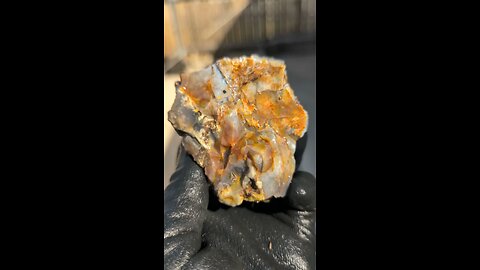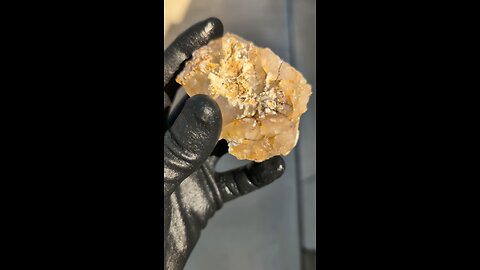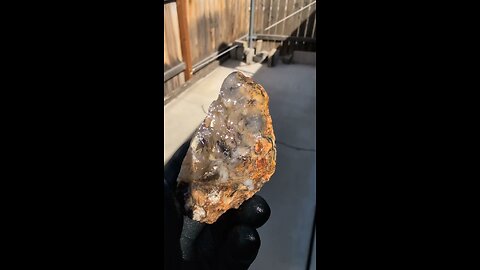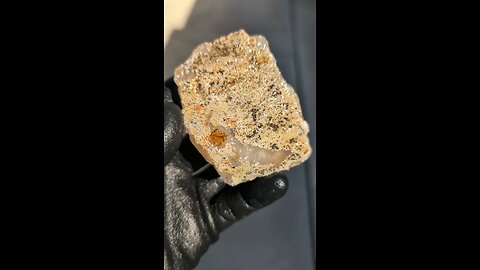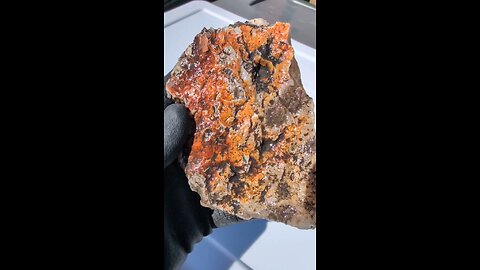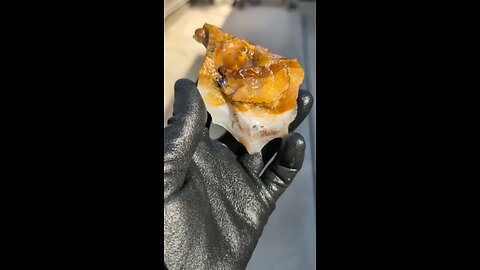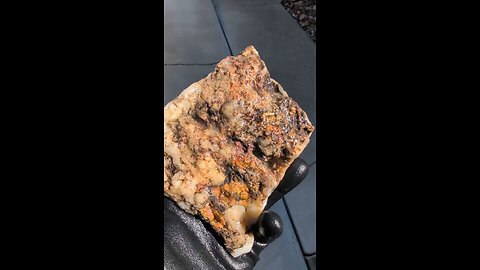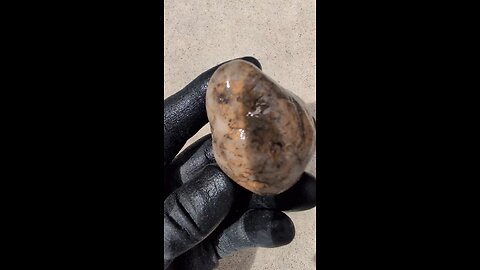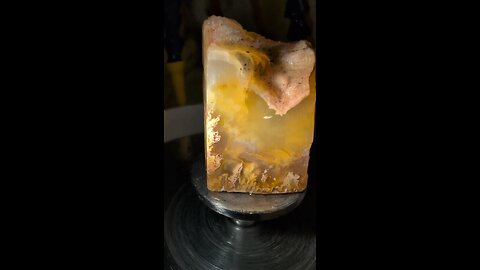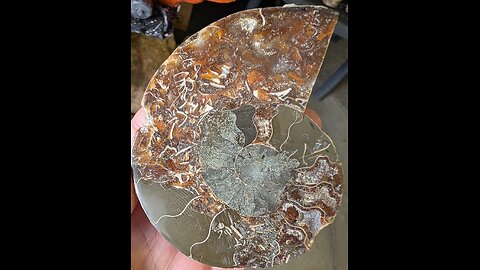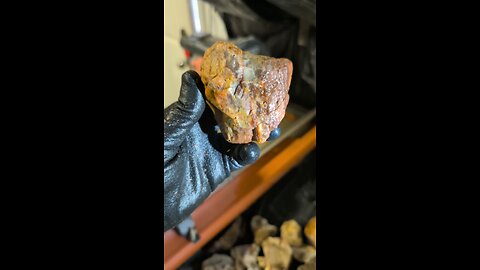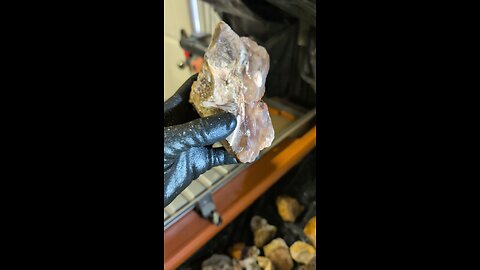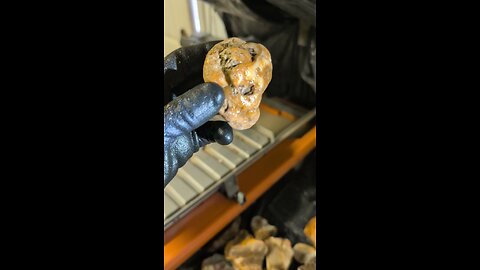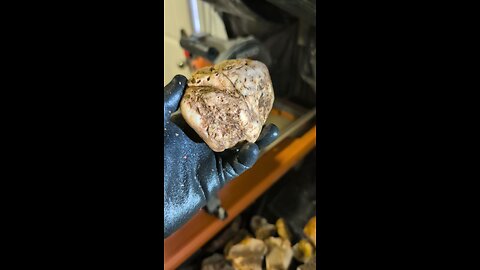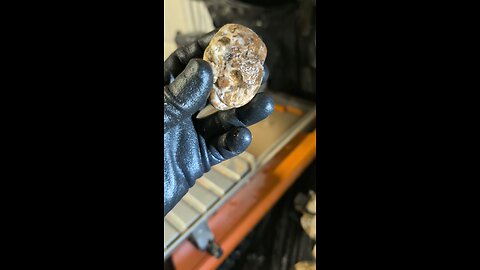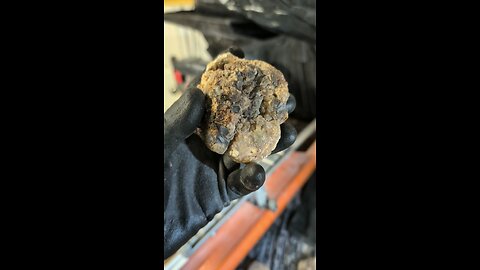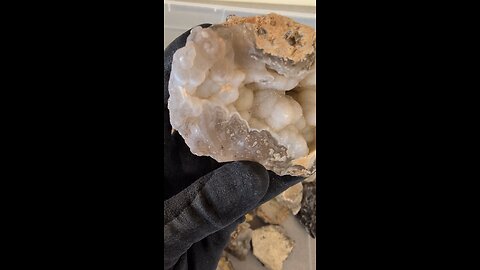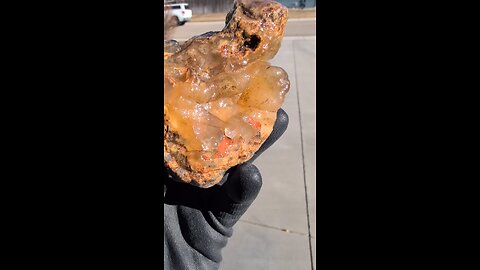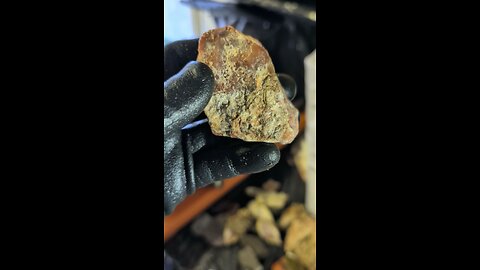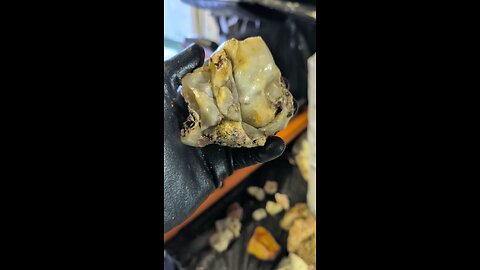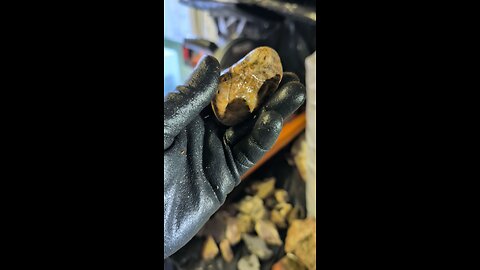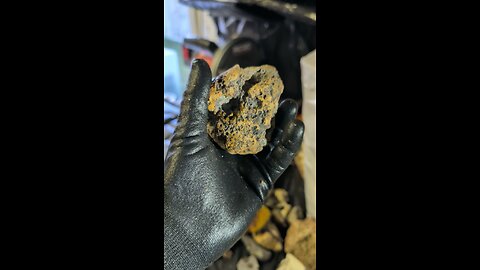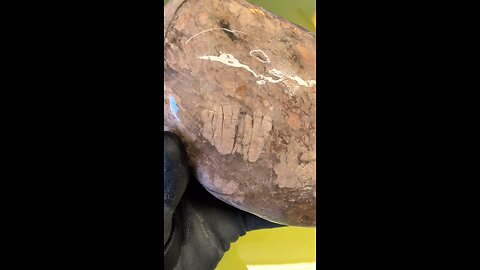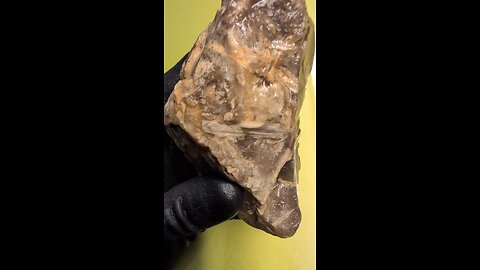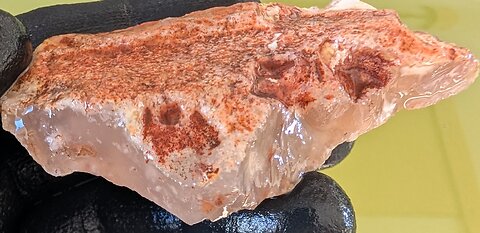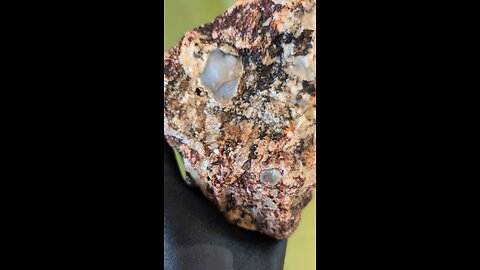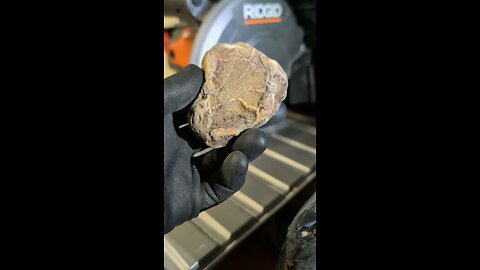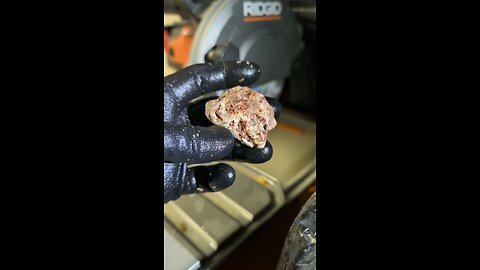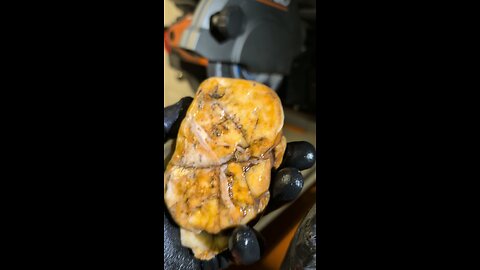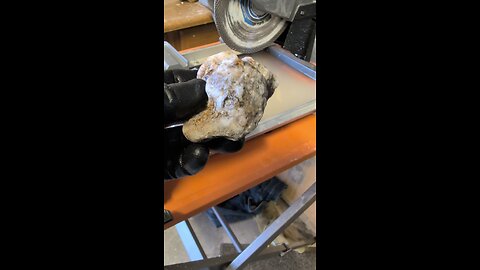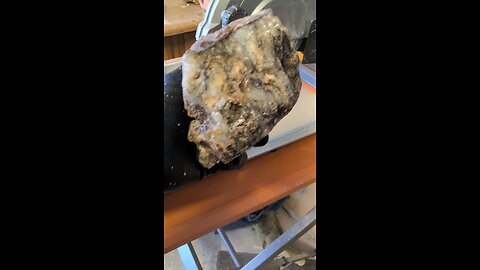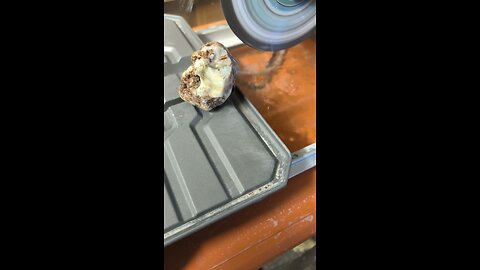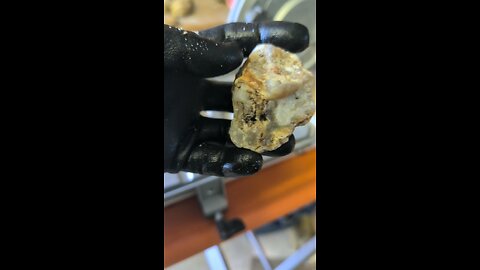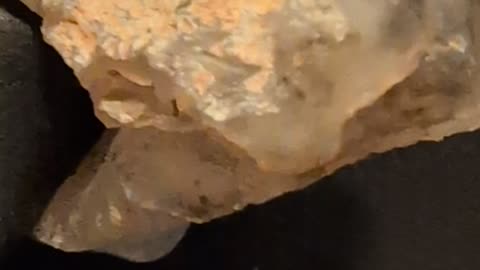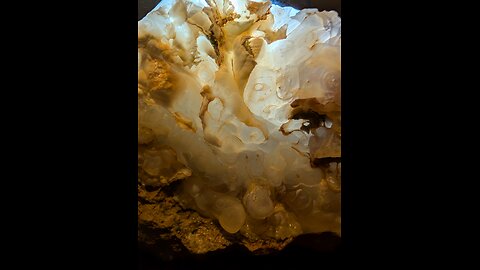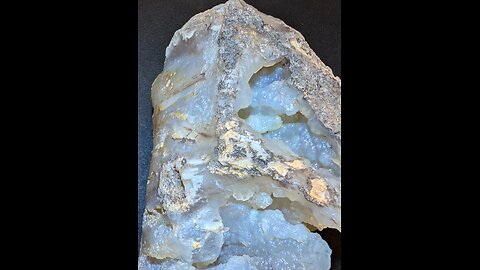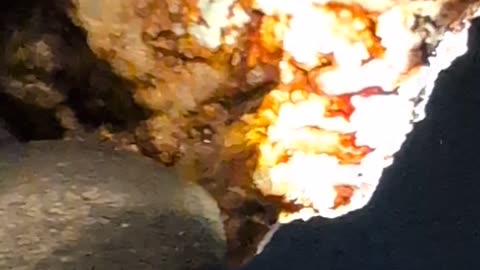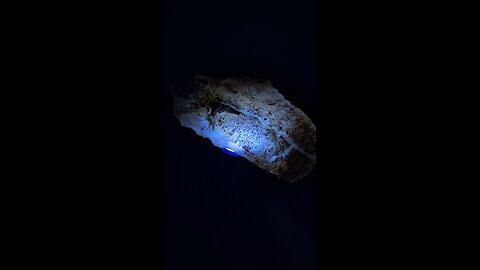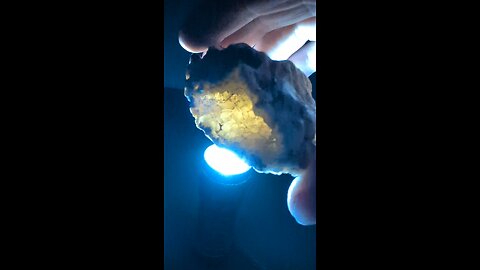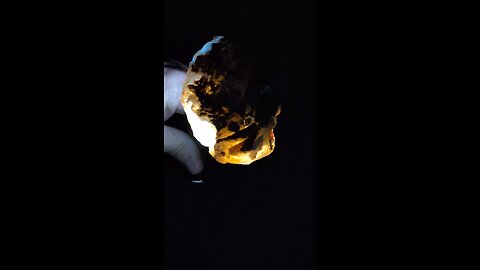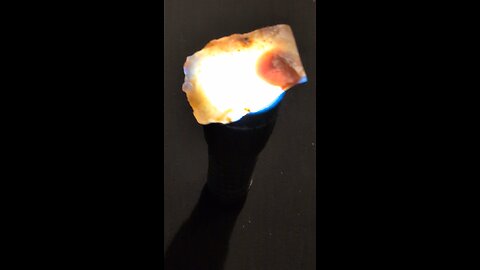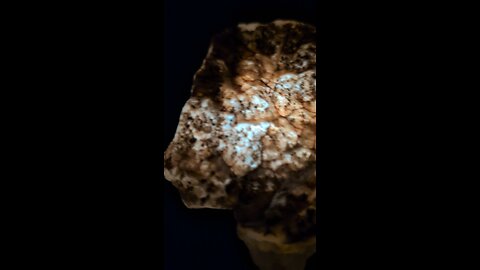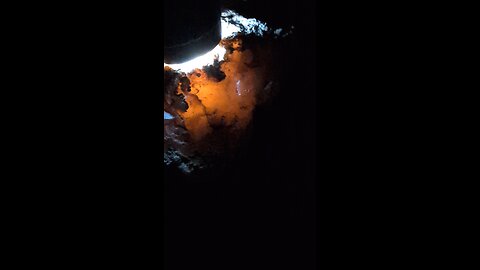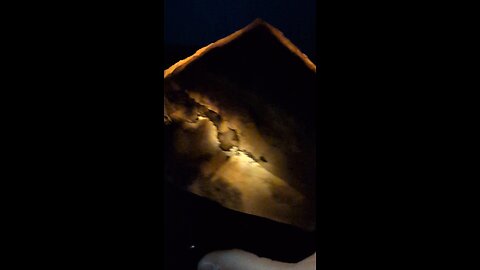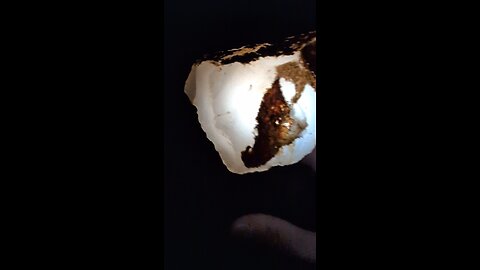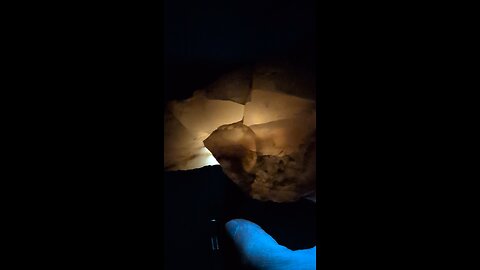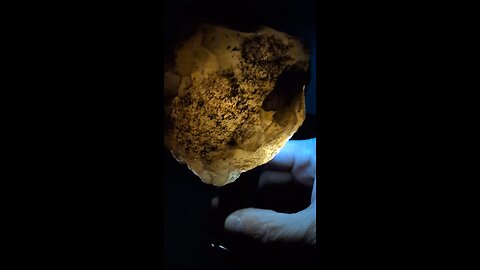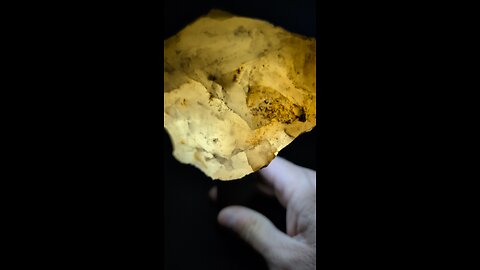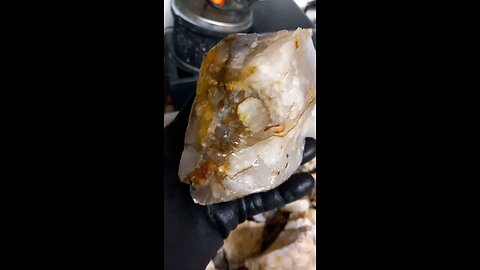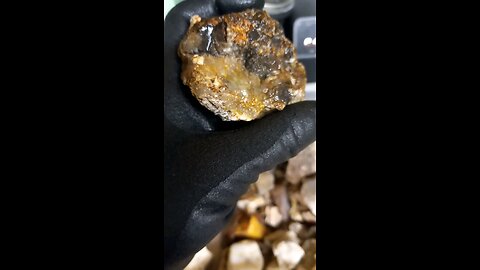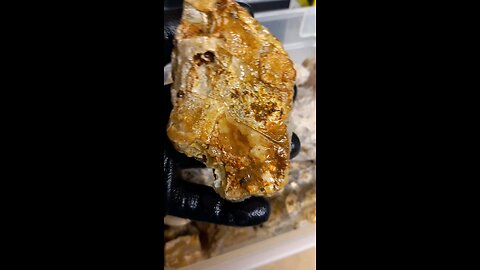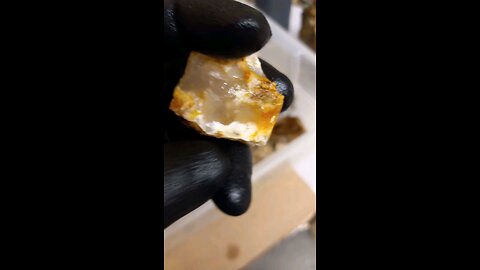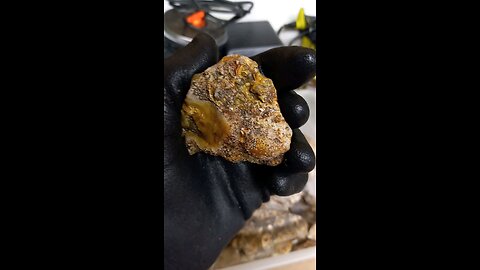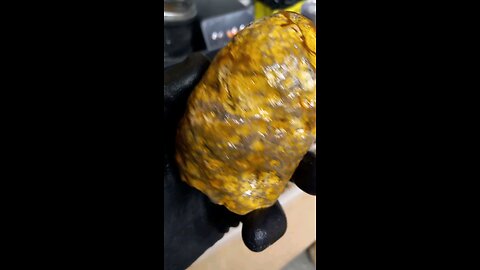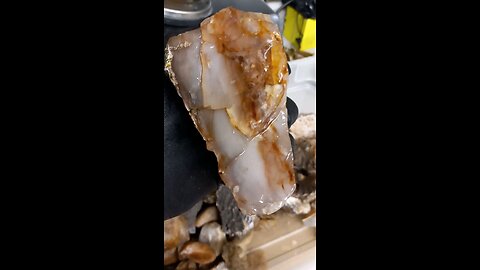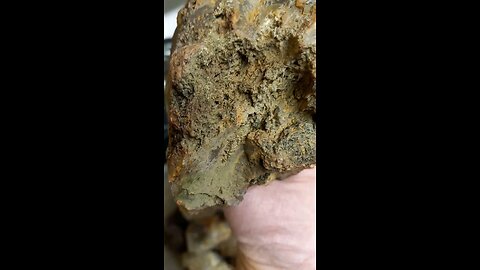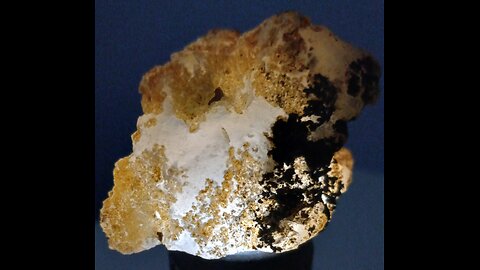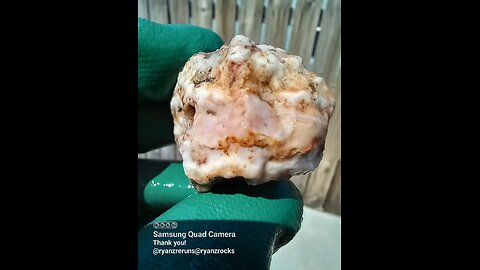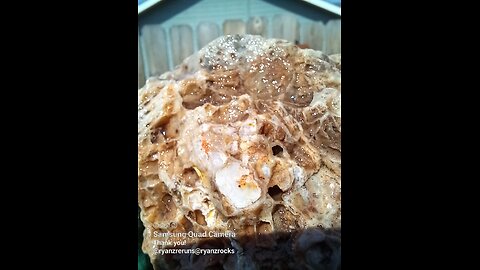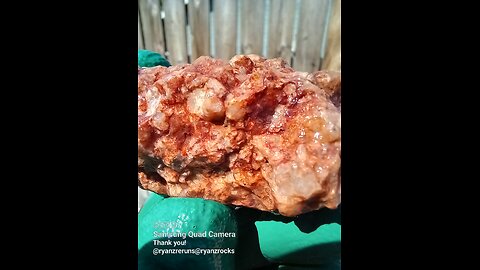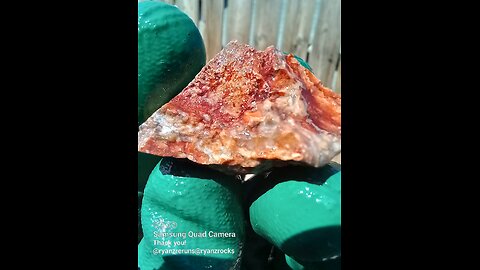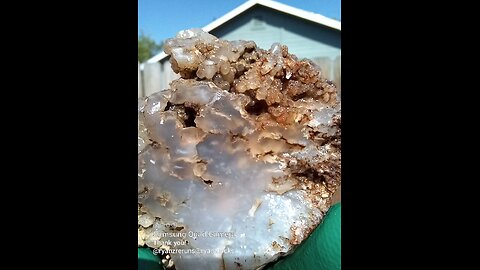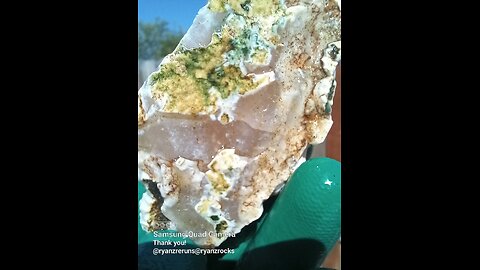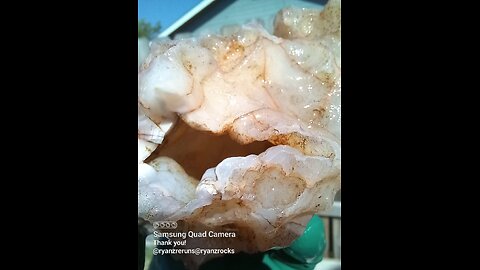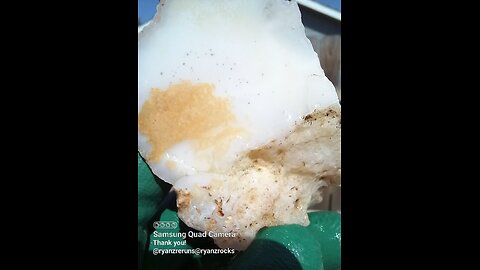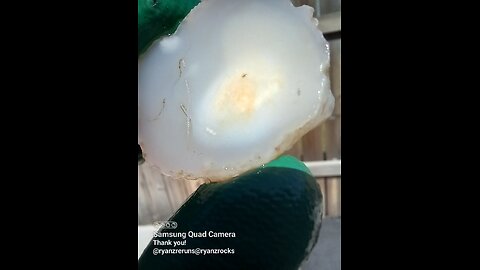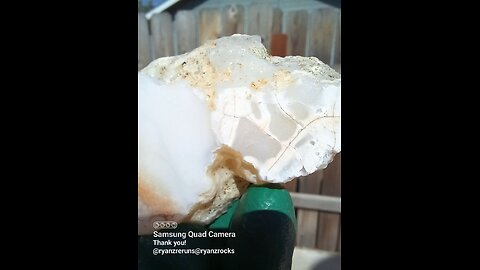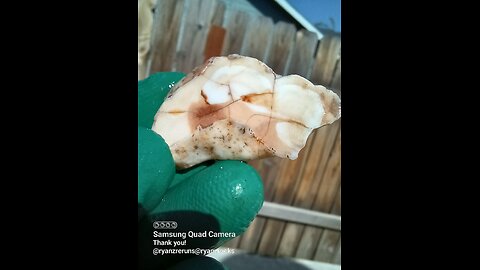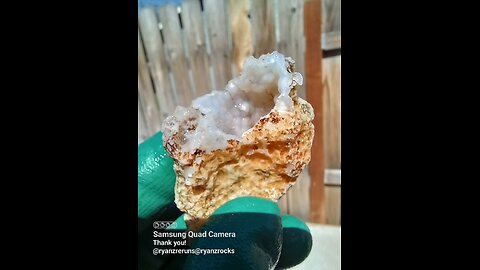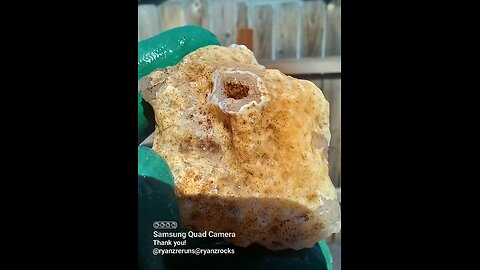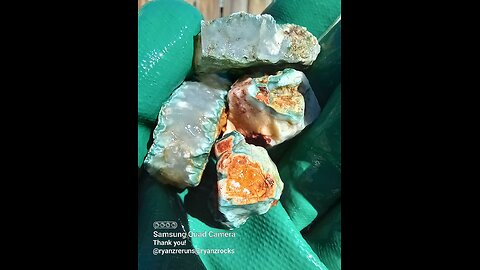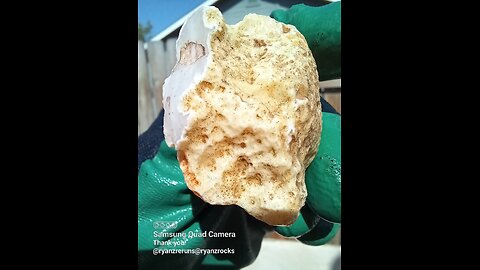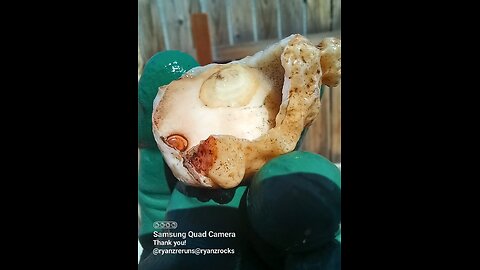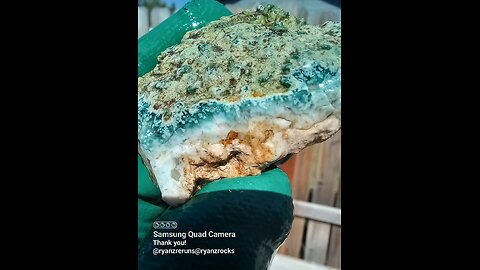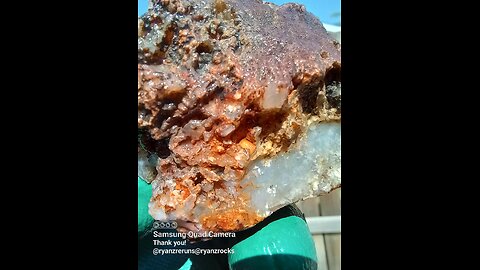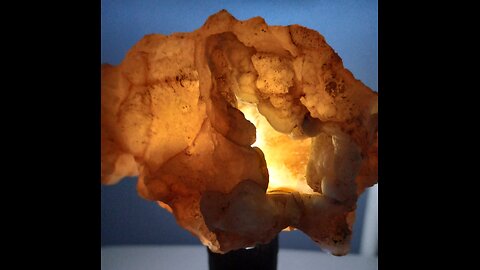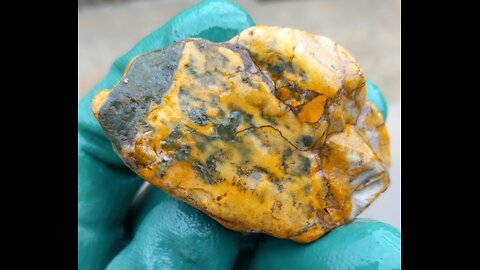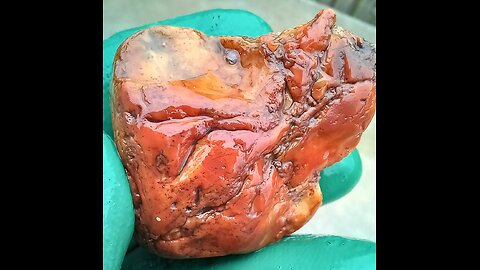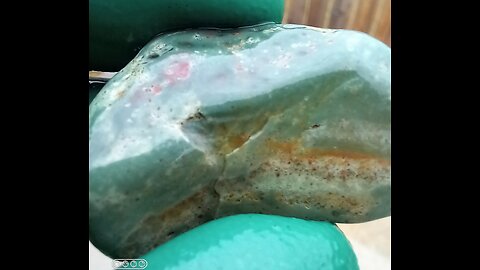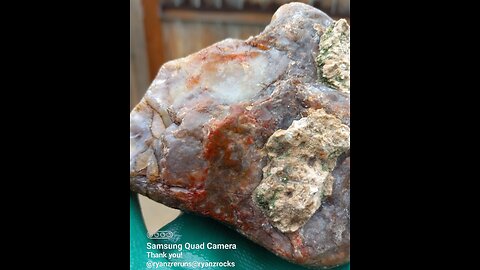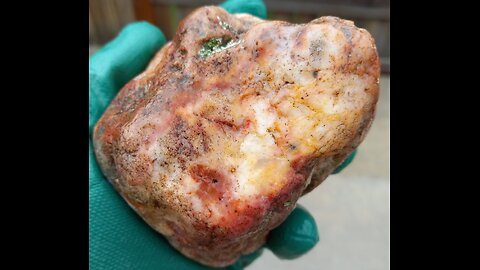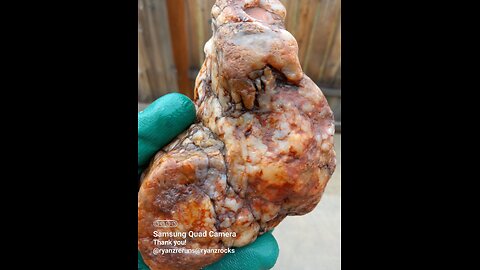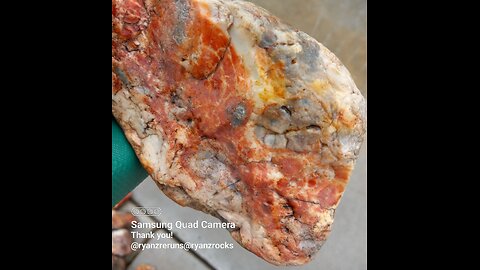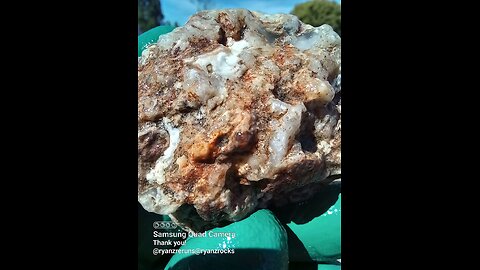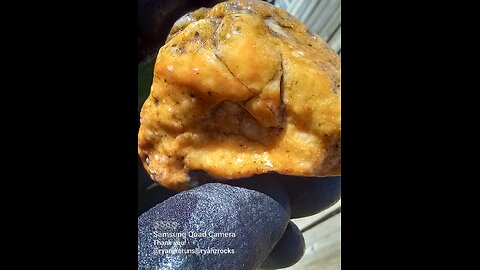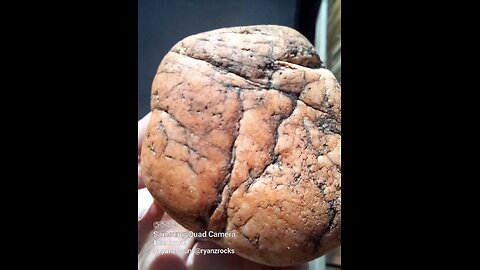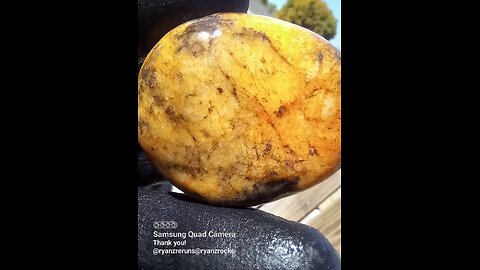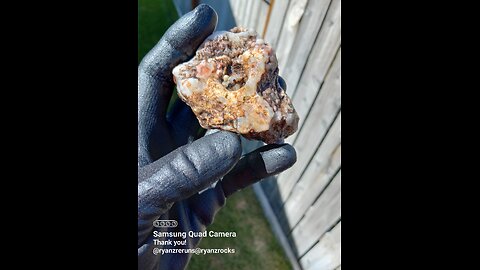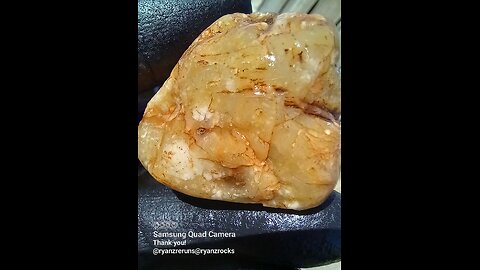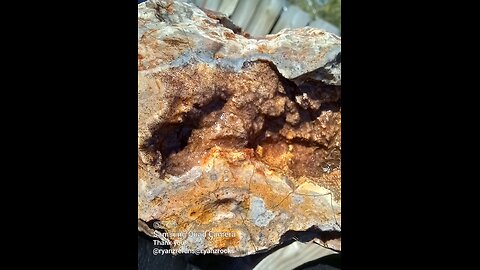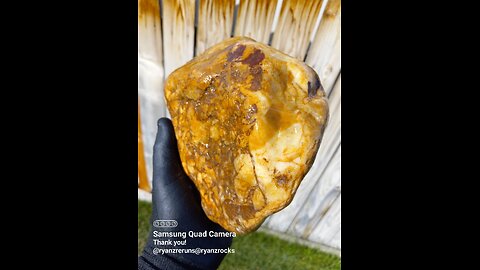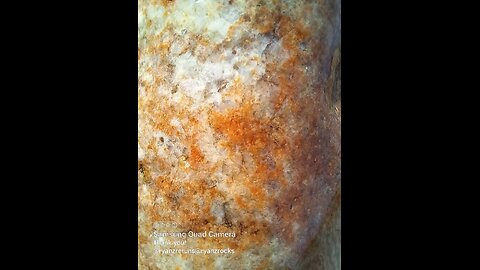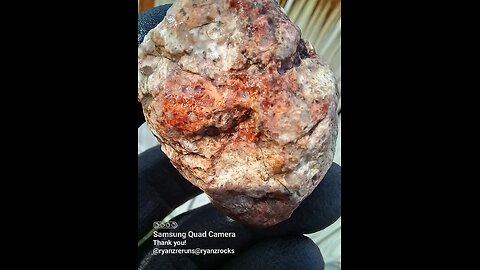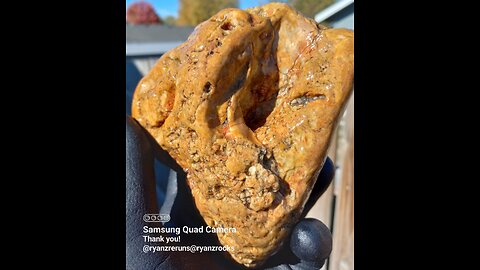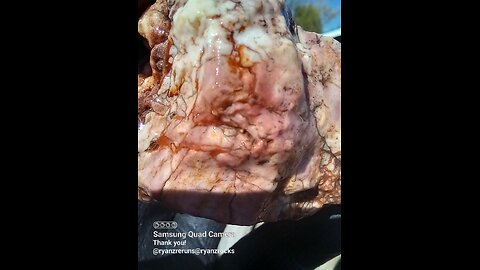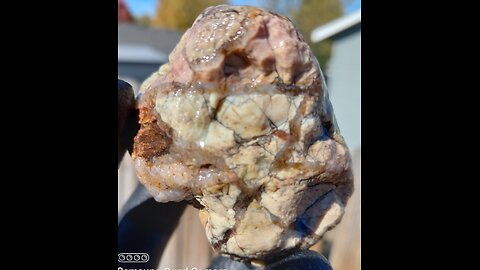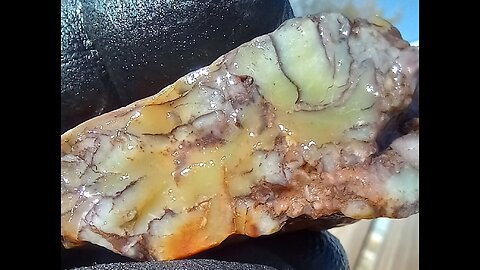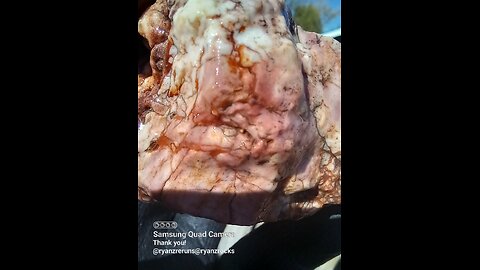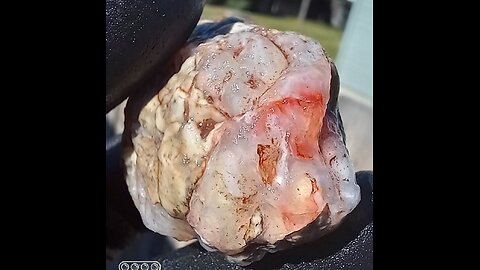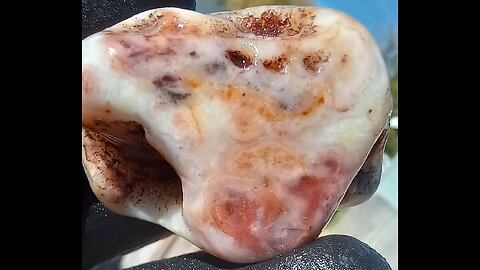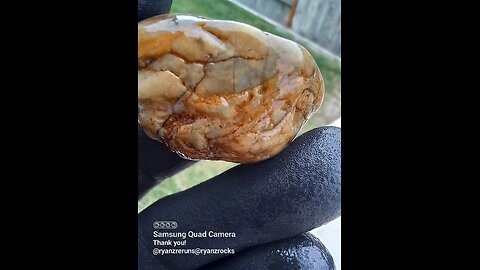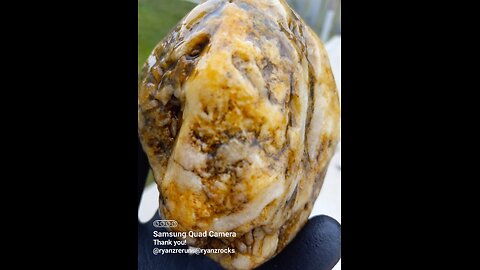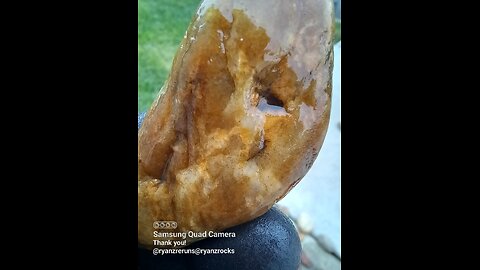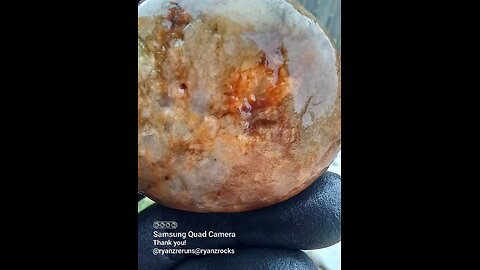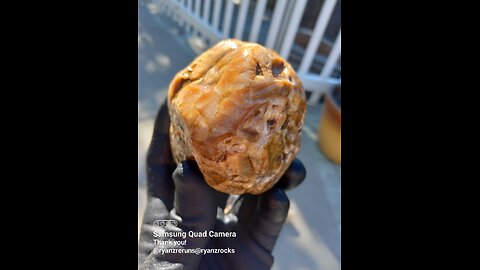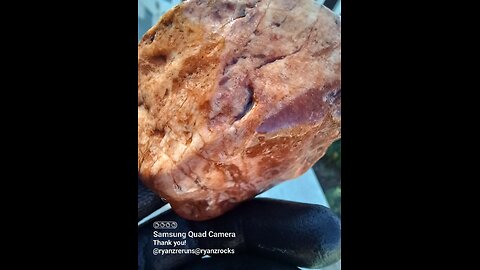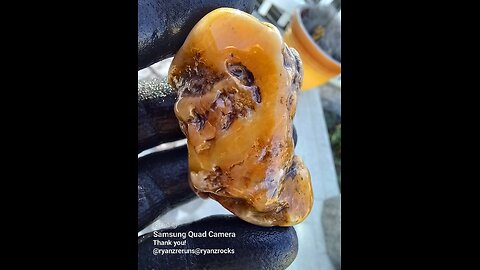Premium Only Content
This video is only available to Rumble Premium subscribers. Subscribe to
enjoy exclusive content and ad-free viewing.
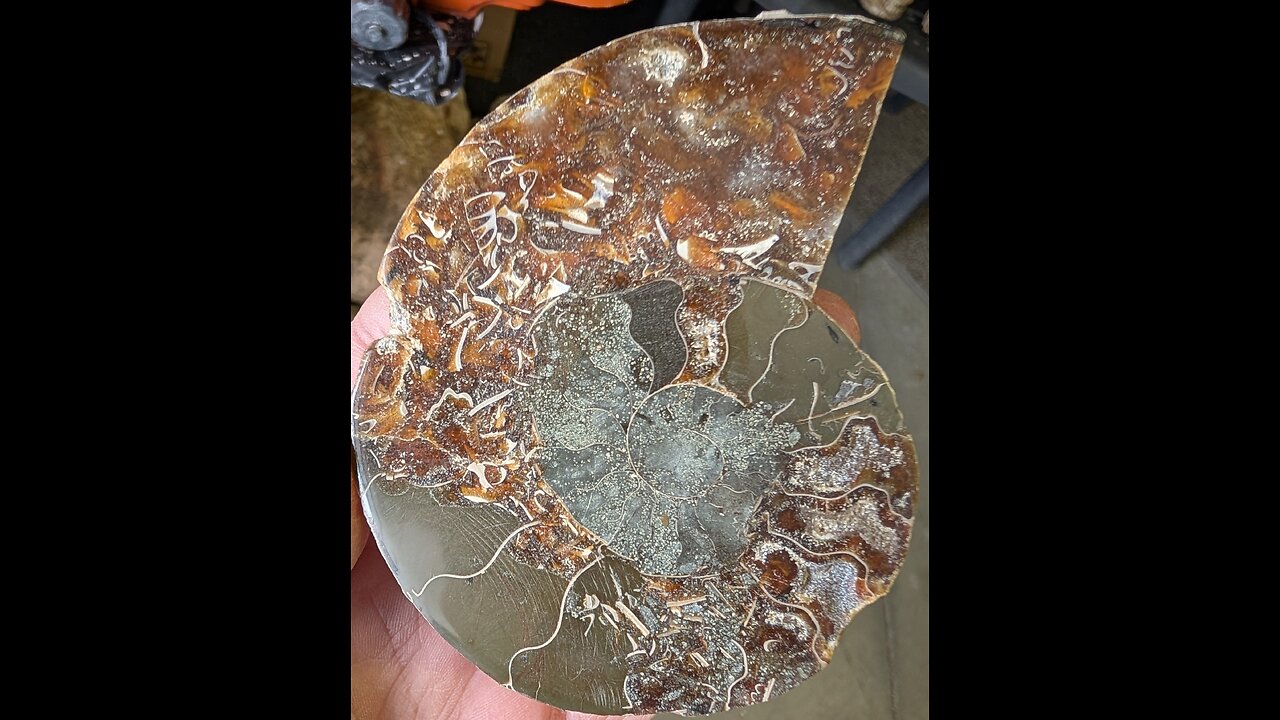
Agates!
HumbleConservative
- 10 / 143
1
Plume Agate with Brecciated Jasper!
HumbleConservative
Plume agate is a distinctive variety of agate, known for its unique and intricate patterns that resemble plumes, feathers, or even landscapes. Here are some key points about plume agate:
Formation: Plume agate forms when silica-rich solutions seep into cavities in volcanic rocks. The "plumes" are created by manganese or iron oxides that get trapped in the silica, forming these feather-like patterns.
Colors: The colors of plume agate can vary widely depending on the minerals present. Common colors include reds, browns, yellows, blacks, and whites, with the plumes often contrasting against the base color of the agate.
Locations: Notable locations where plume agate is found include Oregon in the United States (specifically, the Owyhee Mountain area), Mexico, and Brazil. Each location can produce agates with unique characteristics.
Uses: Plume agate is popular among collectors and is often used in jewelry like pendants, rings, and beads due to its aesthetic appeal. It's also valued in metaphysical communities, where it's believed to enhance one's connection to the Earth, promote creativity, and aid in grounding.
Care: Like other agates, plume agate is relatively hard (about 6.5-7 on the Mohs scale), making it durable for jewelry. However, it should be protected from sharp blows or extreme temperature changes to avoid cracking.
Identification: When identifying plume agate, look for the characteristic plume-like inclusions. These inclusions should appear as if they are floating within the stone, giving a 3D effect when viewed from different angles.
Plume agate's beauty lies in its natural patterns, which can look like trees, clouds, or even abstract art, making each piece unique.
Brecciated Jasper is a type of jasper that is characterized by its appearance as broken fragments or pieces of jasper that have been naturally cemented together. Here's a more detailed explanation:
Formation: Brecciated Jasper forms when existing jasper is fractured or broken into pieces due to geological processes like tectonic activity or weathering. These fragments are then cemented together by silica or other minerals, often quartz, which fills the spaces between the fragments.
Appearance: It typically has a distinctive, mosaic-like pattern where the jasper fragments are angular and vary in size, creating a visually striking contrast with the matrix that holds them together. The colors can range from red, brown, yellow, to white, depending on the impurities present in the jasper and the matrix material.
Uses: Due to its unique and attractive pattern, Brecciated Jasper is commonly used in jewelry, carvings, and decorative items. It's valued for its aesthetic appeal and the interesting geological story it tells.
Properties: Like other types of jasper, Brecciated Jasper is relatively hard (around 6.5 to 7 on the Mohs scale), making it durable for various uses. It also has a waxy to vitreous luster when polished.
This type of jasper not only adds beauty to various crafts but also provides insight into the geological processes that have shaped our planet.
2
Interesting Botryoidal Formation!
HumbleConservative
A botryoidal formation refers to a mineral structure that resembles a cluster of grapes or small, rounded, and knobby protrusions. Here are some details about botryoidal formations:
Characteristics:
Shape: The term "botryoidal" comes from the Greek word "botryoeides," meaning "grape-like." These formations have a surface that looks like a bunch of grapes.
Texture: They typically have a smooth, rounded surface, which can sometimes be polished to enhance their appearance.
Formation:
Process: Botryoidal formations occur when minerals precipitate from solution in a manner that favors the growth of rounded, nodular shapes. This often happens in cavities or vugs where mineral-rich fluids slowly deposit layers over time.
Common Minerals: Minerals that commonly form botryoidal structures include:
Hematite: Often found in botryoidal forms, giving a shiny, metallic luster.
Malachite: Known for its vibrant green color in botryoidal formations.
Goethite: Can exhibit botryoidal textures, often with a brownish to yellowish hue.
Chalcedony: Sometimes forms botryoidal structures, especially in agates.
Examples:
Botryoidal Hematite: Often found in iron-rich environments, it has a metallic sheen and can be polished to a high gloss.
Botryoidal Malachite: Famous for its green color and banding, often found in the oxidized zones of copper deposits.
Locations:
Botryoidal formations can be found worldwide in various geological settings where mineral precipitation occurs, from mines to natural rock formations.
Uses:
Decorative: Botryoidal minerals are popular in mineral collections and for decorative purposes due to their unique and attractive appearance.
Jewelry: Some botryoidal minerals like malachite are cut and polished for use in jewelry.
Botryoidal formations are fascinating because they provide insight into the conditions under which they formed, often indicating slow, steady mineral deposition in specific environmental conditions.
Plume agate is a distinctive variety of agate, known for its unique and intricate patterns that resemble plumes, feathers, or even landscapes. Here are some key points about plume agate:
Formation: Plume agate forms when silica-rich solutions seep into cavities in volcanic rocks. The "plumes" are created by manganese or iron oxides that get trapped in the silica, forming these feather-like patterns.
Colors: The colors of plume agate can vary widely depending on the minerals present. Common colors include reds, browns, yellows, blacks, and whites, with the plumes often contrasting against the base color of the agate.
Locations: Notable locations where plume agate is found include Oregon in the United States (specifically, the Owyhee Mountain area), Mexico, and Brazil. Each location can produce agates with unique characteristics.
Uses: Plume agate is popular among collectors and is often used in jewelry like pendants, rings, and beads due to its aesthetic appeal. It's also valued in metaphysical communities, where it's believed to enhance one's connection to the Earth, promote creativity, and aid in grounding.
Care: Like other agates, plume agate is relatively hard (about 6.5-7 on the Mohs scale), making it durable for jewelry. However, it should be protected from sharp blows or extreme temperature changes to avoid cracking.
Identification: When identifying plume agate, look for the characteristic plume-like inclusions. These inclusions should appear as if they are floating within the stone, giving a 3D effect when viewed from different angles.
Plume agate's beauty lies in its natural patterns, which can look like trees, clouds, or even abstract art, making each piece unique.
3
Plume chunk!
HumbleConservative
Plume agate is a distinctive variety of agate, known for its unique and intricate patterns that resemble plumes, feathers, or even landscapes. Here are some key points about plume agate:
Formation: Plume agate forms when silica-rich solutions seep into cavities in volcanic rocks. The "plumes" are created by manganese or iron oxides that get trapped in the silica, forming these feather-like patterns.
Colors: The colors of plume agate can vary widely depending on the minerals present. Common colors include reds, browns, yellows, blacks, and whites, with the plumes often contrasting against the base color of the agate.
Locations: Notable locations where plume agate is found include Oregon in the United States (specifically, the Owyhee Mountain area), Mexico, and Brazil. Each location can produce agates with unique characteristics.
Uses: Plume agate is popular among collectors and is often used in jewelry like pendants, rings, and beads due to its aesthetic appeal. It's also valued in metaphysical communities, where it's believed to enhance one's connection to the Earth, promote creativity, and aid in grounding.
Care: Like other agates, plume agate is relatively hard (about 6.5-7 on the Mohs scale), making it durable for jewelry. However, it should be protected from sharp blows or extreme temperature changes to avoid cracking.
Identification: When identifying plume agate, look for the characteristic plume-like inclusions. These inclusions should appear as if they are floating within the stone, giving a 3D effect when viewed from different angles.
Plume agate's beauty lies in its natural patterns, which can look like trees, clouds, or even abstract art, making each piece unique.
4
Slice O' Plume!
HumbleConservative
Plume agate is a distinctive variety of agate, known for its unique and intricate patterns that resemble plumes, feathers, or even landscapes. Here are some key points about plume agate:
Formation: Plume agate forms when silica-rich solutions seep into cavities in volcanic rocks. The "plumes" are created by manganese or iron oxides that get trapped in the silica, forming these feather-like patterns.
Colors: The colors of plume agate can vary widely depending on the minerals present. Common colors include reds, browns, yellows, blacks, and whites, with the plumes often contrasting against the base color of the agate.
Locations: Notable locations where plume agate is found include Oregon in the United States (specifically, the Owyhee Mountain area), Mexico, and Brazil. Each location can produce agates with unique characteristics.
Uses: Plume agate is popular among collectors and is often used in jewelry like pendants, rings, and beads due to its aesthetic appeal. It's also valued in metaphysical communities, where it's believed to enhance one's connection to the Earth, promote creativity, and aid in grounding.
Care: Like other agates, plume agate is relatively hard (about 6.5-7 on the Mohs scale), making it durable for jewelry. However, it should be protected from sharp blows or extreme temperature changes to avoid cracking.
Identification: When identifying plume agate, look for the characteristic plume-like inclusions. These inclusions should appear as if they are floating within the stone, giving a 3D effect when viewed from different angles.
Plume agate's beauty lies in its natural patterns, which can look like trees, clouds, or even abstract art, making each piece unique.
5
Plume Agate!
HumbleConservative
Plume agate is a distinctive variety of agate, known for its unique and intricate patterns that resemble plumes, feathers, or even landscapes. Here are some key points about plume agate:
Formation: Plume agate forms when silica-rich solutions seep into cavities in volcanic rocks. The "plumes" are created by manganese or iron oxides that get trapped in the silica, forming these feather-like patterns.
Colors: The colors of plume agate can vary widely depending on the minerals present. Common colors include reds, browns, yellows, blacks, and whites, with the plumes often contrasting against the base color of the agate.
Locations: Notable locations where plume agate is found include Oregon in the United States (specifically, the Owyhee Mountain area), Mexico, and Brazil. Each location can produce agates with unique characteristics.
Uses: Plume agate is popular among collectors and is often used in jewelry like pendants, rings, and beads due to its aesthetic appeal. It's also valued in metaphysical communities, where it's believed to enhance one's connection to the Earth, promote creativity, and aid in grounding.
Care: Like other agates, plume agate is relatively hard (about 6.5-7 on the Mohs scale), making it durable for jewelry. However, it should be protected from sharp blows or extreme temperature changes to avoid cracking.
Identification: When identifying plume agate, look for the characteristic plume-like inclusions. These inclusions should appear as if they are floating within the stone, giving a 3D effect when viewed from different angles.
Plume agate's beauty lies in its natural patterns, which can look like trees, clouds, or even abstract art, making each piece unique.
6
Plume Agate Chunk!
HumbleConservative
Plume agate is a distinctive variety of agate, known for its unique and intricate patterns that resemble plumes, feathers, or even landscapes. Here are some key points about plume agate:
Formation: Plume agate forms when silica-rich solutions seep into cavities in volcanic rocks. The "plumes" are created by manganese or iron oxides that get trapped in the silica, forming these feather-like patterns.
Colors: The colors of plume agate can vary widely depending on the minerals present. Common colors include reds, browns, yellows, blacks, and whites, with the plumes often contrasting against the base color of the agate.
Locations: Notable locations where plume agate is found include Oregon in the United States (specifically, the Owyhee Mountain area), Mexico, and Brazil. Each location can produce agates with unique characteristics.
Uses: Plume agate is popular among collectors and is often used in jewelry like pendants, rings, and beads due to its aesthetic appeal. It's also valued in metaphysical communities, where it's believed to enhance one's connection to the Earth, promote creativity, and aid in grounding.
Care: Like other agates, plume agate is relatively hard (about 6.5-7 on the Mohs scale), making it durable for jewelry. However, it should be protected from sharp blows or extreme temperature changes to avoid cracking.
Identification: When identifying plume agate, look for the characteristic plume-like inclusions. These inclusions should appear as if they are floating within the stone, giving a 3D effect when viewed from different angles.
Plume agate's beauty lies in its natural patterns, which can look like trees, clouds, or even abstract art, making each piece unique.
7
Slab o' Plume!
HumbleConservative
Plume agate is a distinctive variety of agate, known for its unique and intricate patterns that resemble plumes, feathers, or even landscapes. Here are some key points about plume agate:
Formation: Plume agate forms when silica-rich solutions seep into cavities in volcanic rocks. The "plumes" are created by manganese or iron oxides that get trapped in the silica, forming these feather-like patterns.
Colors: The colors of plume agate can vary widely depending on the minerals present. Common colors include reds, browns, yellows, blacks, and whites, with the plumes often contrasting against the base color of the agate.
Locations: Notable locations where plume agate is found include Oregon in the United States (specifically, the Owyhee Mountain area), Mexico, and Brazil. Each location can produce agates with unique characteristics.
Uses: Plume agate is popular among collectors and is often used in jewelry like pendants, rings, and beads due to its aesthetic appeal. It's also valued in metaphysical communities, where it's believed to enhance one's connection to the Earth, promote creativity, and aid in grounding.
Care: Like other agates, plume agate is relatively hard (about 6.5-7 on the Mohs scale), making it durable for jewelry. However, it should be protected from sharp blows or extreme temperature changes to avoid cracking.
Identification: When identifying plume agate, look for the characteristic plume-like inclusions. These inclusions should appear as if they are floating within the stone, giving a 3D effect when viewed from different angles.
Plume agate's beauty lies in its natural patterns, which can look like trees, clouds, or even abstract art, making each piece unique.
8
Quartz+!
HumbleConservative
Quartzite is a metamorphic rock that forms from the metamorphism of quartz sandstone or quartz-rich sedimentary rock. Here are some key points about quartzite:
Formation: Quartzite forms when quartz sandstone is subjected to high temperatures and pressures, typically during regional metamorphism. This process recrystallizes the quartz grains, fusing them together, and sometimes introduces new minerals.
Composition: It is predominantly composed of quartz, with minor amounts of other minerals like mica, feldspar, or iron oxides, which can affect its color.
Texture: Quartzite has a granular texture but becomes more compact and crystalline with metamorphism. Unlike sandstone, which can be porous, quartzite is typically very dense and hard.
Color: Pure quartzite is usually white or light gray, but impurities can give it colors ranging from pink, red, yellow, to green or blue. Iron oxides can tint it red or yellow, while other minerals might contribute different hues.
Properties:
Hardness: Quartzite is very hard, with a Mohs hardness of about 7, similar to quartz.
Durability: It's highly resistant to weathering and erosion, making it durable for various uses.
Uses:
Construction: Due to its hardness and aesthetic appeal, quartzite is used in building facades, flooring, countertops, and as a decorative stone.
Landscaping: It's popular in landscaping for paths, walls, and decorative elements because of its durability.
Art: Its fine grain and ability to take a high polish make it suitable for sculptures and carvings.
Geological Significance: Quartzite provides evidence of past geological processes, particularly the conditions of metamorphism. It can help geologists understand the history of mountain building and the transformation of sedimentary rocks into metamorphic ones.
1
comment
9
Moss Agate Polish!
HumbleConservative
Moss agate is a type of chalcedony, a mineral in the quartz family, known for its unique and beautiful appearance. It’s typically translucent to semi-opaque with a milky or clear base, featuring green, moss-like inclusions that resemble tiny ferns, trees, or landscapes. These inclusions are usually formed by minerals like chlorite, iron, or manganese, giving it that earthy, forest-floor vibe.
Unlike true agates, which have banded patterns, moss agate doesn’t always show banding—its charm lies in those organic, dendritic (branch-like) designs. It’s often used in jewelry, like rings or pendants, because of its durability (it’s about a 6.5-7 on the Mohs hardness scale) and its one-of-a-kind look. People also associate it with calming, grounding energy in crystal enthusiast circles, though that’s more anecdotal than scientific.
Found in places like India, Brazil, and the U.S., it’s been prized for centuries, even popping up in ancient cultures for decorative or spiritual uses. Each piece is a little different, which is part of what makes it so cool.
1
comment
Ammonite fossil!
HumbleConservative
The fossil in the image appears to be a cross-section of an ammonite. Ammonites are a group of extinct marine mollusks within the class Cephalopoda, related to modern squids, octopuses, and nautiluses. The distinctive spiral shell with internal chambers is a key characteristic of ammonites. The chambers are divided by septa, which are the walls you see in the fossil, and the intricate patterns are typical of the internal structure of ammonite shells.
1
comment
11
Agate Drop!
HumbleConservative
Agate is a microcrystalline variety of quartz, specifically a form of chalcedony, known for its fine grain and bright color patterns. Here are some key points about agate:
Formation: Agate forms in volcanic and sedimentary rocks. It often begins as a cavity in the rock, which then gets filled with layers of silica-rich water. Over time, this solution deposits minerals in layers, creating the characteristic banding of agate. This process can take millions of years.
Appearance: Agate is famous for its beautiful, often banded patterns of color, which can range from translucent to opaque. Colors include white, blue, red, black, yellow, and brown among others, with the patterns formed by the successive layers of chalcedony being deposited. Sometimes, agates can be found with inclusions like moss (moss agate) or even fossils.
Types of Agate:
Banded Agate: Shows clear, concentric bands of color.
Moss Agate: Contains mineral inclusions that look like moss or foliage.
Dendritic Agate: Similar to moss agate but with tree-like or branch-like patterns.
Fire Agate: Contains iridescent layers that appear to glow with fiery colors.
Lace Agate: Features lace-like patterns, most notably in Blue Lace Agate from Namibia.
Crazy Lace Agate: Known for its wild, chaotic patterns of colors.
Locations: Agates are found worldwide, but some of the most famous locations include Brazil, Uruguay, Mexico, Germany, Madagascar, and the United States (particularly in Oregon, Washington, and Idaho).
Uses:
Jewelry: Due to its beauty when polished, agate is widely used in jewelry like rings, pendants, and beads.
Decorative Items: Larger pieces or slices are used for decorative objects, bookends, or as display pieces.
Metaphysical: In metaphysical practices, agate is believed to have various healing properties, like balancing physical, emotional, and intellectual energy, and promoting strength and courage.
Cultural Significance: Agate has been used since ancient times; it was prized in Ancient Egypt for amulets and seals, in Greece and Rome for intaglios and cameos, and by many other cultures for its beauty and supposed protective qualities.
Cutting and Polishing: When cutting agate for jewelry or display, lapidaries look for the most visually appealing patterns. The process involves sawing, grinding, and polishing to bring out the internal beauty of the stone.
Agate's diversity in color and pattern, combined with its durability, makes it one of the most sought-after stones in the world of gemology and mineral collecting.
12
Agatized wood!
HumbleConservative
This looks like petrified wood.
The distinct wood grain pattern visible on the surface, combined with the stone-like texture and the various colors, are strong indicators of petrified wood.
Petrification is a process where organic material is replaced by minerals, essentially turning wood into stone while preserving its original structure. The colors are often due to the minerals present during the petrification process.
13
Plume Cut!
HumbleConservative
Plume agate is a distinctive variety of agate, known for its unique and intricate patterns that resemble plumes, feathers, or even landscapes. Here are some key points about plume agate:
Formation: Plume agate forms when silica-rich solutions seep into cavities in volcanic rocks. The "plumes" are created by manganese or iron oxides that get trapped in the silica, forming these feather-like patterns.
Colors: The colors of plume agate can vary widely depending on the minerals present. Common colors include reds, browns, yellows, blacks, and whites, with the plumes often contrasting against the base color of the agate.
Locations: Notable locations where plume agate is found include Oregon in the United States (specifically, the Owyhee Mountain area), Mexico, and Brazil. Each location can produce agates with unique characteristics.
Uses: Plume agate is popular among collectors and is often used in jewelry like pendants, rings, and beads due to its aesthetic appeal. It's also valued in metaphysical communities, where it's believed to enhance one's connection to the Earth, promote creativity, and aid in grounding.
Care: Like other agates, plume agate is relatively hard (about 6.5-7 on the Mohs scale), making it durable for jewelry. However, it should be protected from sharp blows or extreme temperature changes to avoid cracking.
Identification: When identifying plume agate, look for the characteristic plume-like inclusions. These inclusions should appear as if they are floating within the stone, giving a 3D effect when viewed from different angles.
Plume agate's beauty lies in its natural patterns, which can look like trees, clouds, or even abstract art, making each piece unique.
14
Agatized wood!
HumbleConservative
This rock appears to be agatized wood, also known as petrified wood with agate.
Here's why:
* Wood Grain Presence: You can still see the distinct wood grain structure, indicating it was once wood.
* Agate Inclusions: The darker, bubbly or layered formations within the wood grain are likely agate. Agate is a type of chalcedony (a form of quartz) that often fills voids and replaces organic material in petrified wood.
* Color Variation: The mix of earthy tones (browns, tans, creams) along with the darker, more translucent areas (likely the agate) is typical of agatized wood.
Agatized wood is a fascinating combination of fossilized wood and agate, making it a popular material for collectors and lapidary artists.
15
Plume ball!
HumbleConservative
Plume agate is a distinctive variety of agate, known for its unique and intricate patterns that resemble plumes, feathers, or even landscapes. Here are some key points about plume agate:
Formation: Plume agate forms when silica-rich solutions seep into cavities in volcanic rocks. The "plumes" are created by manganese or iron oxides that get trapped in the silica, forming these feather-like patterns.
Colors: The colors of plume agate can vary widely depending on the minerals present. Common colors include reds, browns, yellows, blacks, and whites, with the plumes often contrasting against the base color of the agate.
Locations: Notable locations where plume agate is found include Oregon in the United States (specifically, the Owyhee Mountain area), Mexico, and Brazil. Each location can produce agates with unique characteristics.
Uses: Plume agate is popular among collectors and is often used in jewelry like pendants, rings, and beads due to its aesthetic appeal. It's also valued in metaphysical communities, where it's believed to enhance one's connection to the Earth, promote creativity, and aid in grounding.
Care: Like other agates, plume agate is relatively hard (about 6.5-7 on the Mohs scale), making it durable for jewelry. However, it should be protected from sharp blows or extreme temperature changes to avoid cracking.
Identification: When identifying plume agate, look for the characteristic plume-like inclusions. These inclusions should appear as if they are floating within the stone, giving a 3D effect when viewed from different angles.
Plume agate's beauty lies in its natural patterns, which can look like trees, clouds, or even abstract art, making each piece unique.
16
Agate Cut!
HumbleConservative
Based on the image provided, the rock appears to be a type of agate, specifically a moss agate. Moss agate is characterized by its green inclusions that resemble moss, although in this specimen, the inclusions are more brown and yellowish. These inclusions are typically composed of minerals like iron or manganese oxides. The rock also shows some banding and crystalline structures, which are typical features of agates.
Moss agates are often found in volcanic rock and are prized for their unique patterns and colors.
17
Black plume!
HumbleConservative
Based on the appearance of the rock in the image, it looks like a type of agate, specifically a Moss Agate or Fortification Agate. Here's why:
Coloration: The rock has a mix of translucent to semi-translucent areas with inclusions of various colors, including brown, black, and some hints of yellow and green. This is typical of agates which often have colorful inclusions due to the presence of different minerals.
Patterns: The patterns in the rock, including the banding and the moss-like inclusions, are characteristic of moss agate. Moss agate is known for its green, brown, or black inclusions that resemble moss or foliage within the stone.
Translucency: The rock has a somewhat translucent quality, especially around the edges, which is common in agates due to their silica composition.
Agates are formed from silica-rich water depositing layers in cavities within volcanic rocks or other types of rock formations. The specific patterns and colors depend on the minerals present in the water during the formation process.
18
Agate Cut!
HumbleConservative
This rock appears to be a type of agate, specifically a banded agate or onyx. Here's why:
Coloration and Banding: The rock shows distinct bands of color, which is characteristic of agate. The bands can be seen in various shades of white, brown, and hints of orange or yellow, which is typical for agates due to the layering of different minerals during its formation.
Translucency: Agates are known for their translucency, especially when polished or cut like in your image. The rock has a semi-translucent quality, particularly in the white and lighter areas.
Patterns: The patterns in the rock, including the banding and some moss-like or dendritic inclusions, are common in agates. These patterns form due to the slow deposition of silica in cavities within volcanic rocks or other types of rock formations.
1
comment
19
Botryoidal Geode!
HumbleConservative
This rock appears to be a geode filled with chalcedony or agate. Here's a detailed explanation:
Geode: Geodes are hollow, vaguely spherical rocks, often formed in volcanic and sedimentary rocks. They have a thin outer layer and are typically lined with crystals inside. The one in the image has been cut open to reveal its interior.
Chalcedony: This is a cryptocrystalline form of silica, composed of very fine intergrowths of quartz and moganite. Chalcedony can appear in various colors and forms, including agate, which has banding or layers.
Agate: If the chalcedony within the geode shows banding or layers, it could be classified as agate. Agate typically has more distinct color bands, which might not be very clear in this specimen due to the type of formation or the cut.
Formation: Geodes form when gas bubbles or volcanic cavities get filled with mineral-rich water. Over time, the minerals precipitate out of the water, forming layers or crystals inside the cavity. In this case, the minerals appear to have formed botryoidal (grape-like) structures, which is common in chalcedony.
Appearance: The white to light gray, rounded, botryoidal formations inside the geode suggest chalcedony. The outer shell seems to be a mix of quartz and possibly some iron staining, giving it the brownish hues.
20
Botryoidal Carnelean!
HumbleConservative
This rock houses Carnelian, a type of chalcedony known for its rich, translucent, and warm orange to red-brown color. Here's why this identification might fit:
Color: Carnelian typically exhibits a range of colors from pale orange to deep red-brown, which matches the coloration seen in the rock in the image.
Translucency: Carnelian is often translucent to semi-translucent, which aligns with the way the light passes through the rock in the image, giving it a somewhat glassy appearance.
Layering: While not as pronounced as in banded agates, carnelian can sometimes show subtle banding or layers of color, which might be seen in the varying shades of orange and brown in the rock.
Texture: Carnelian has a waxy luster when polished, much like other forms of chalcedony, which seems consistent with the appearance of the rock in the image.
Carnelian is often used in jewelry and decorative items due to its vibrant color and attractive appearance. If this rock has been polished or cut for ornamental use, it would ty
21
Big Sexy!
HumbleConservative
Agate is a microcrystalline variety of quartz, specifically a form of chalcedony, known for its fine grain and bright color patterns. Here are some key points about agate:
Formation: Agate forms in volcanic and sedimentary rocks. It often begins as a cavity in the rock, which then gets filled with layers of silica-rich water. Over time, this solution deposits minerals in layers, creating the characteristic banding of agate. This process can take millions of years.
Appearance: Agate is famous for its beautiful, often banded patterns of color, which can range from translucent to opaque. Colors include white, blue, red, black, yellow, and brown among others, with the patterns formed by the successive layers of chalcedony being deposited. Sometimes, agates can be found with inclusions like moss (moss agate) or even fossils.
Types of Agate:
Banded Agate: Shows clear, concentric bands of color.
Moss Agate: Contains mineral inclusions that look like moss or foliage.
Dendritic Agate: Similar to moss agate but with tree-like or branch-like patterns.
Fire Agate: Contains iridescent layers that appear to glow with fiery colors.
Lace Agate: Features lace-like patterns, most notably in Blue Lace Agate from Namibia.
Crazy Lace Agate: Known for its wild, chaotic patterns of colors.
Locations: Agates are found worldwide, but some of the most famous locations include Brazil, Uruguay, Mexico, Germany, Madagascar, and the United States (particularly in Oregon, Washington, and Idaho).
Uses:
Jewelry: Due to its beauty when polished, agate is widely used in jewelry like rings, pendants, and beads.
Decorative Items: Larger pieces or slices are used for decorative objects, bookends, or as display pieces.
Metaphysical: In metaphysical practices, agate is believed to have various healing properties, like balancing physical, emotional, and intellectual energy, and promoting strength and courage.
Cultural Significance: Agate has been used since ancient times; it was prized in Ancient Egypt for amulets and seals, in Greece and Rome for intaglios and cameos, and by many other cultures for its beauty and supposed protective qualities.
Cutting and Polishing: When cutting agate for jewelry or display, lapidaries look for the most visually appealing patterns. The process involves sawing, grinding, and polishing to bring out the internal beauty of the stone.
Agate's diversity in color and pattern, combined with its durability, makes it one of the most sought-after stones in the world of gemology and mineral collecting.
22
Botryoidal Plume Agate!
HumbleConservative
A botryoidal formation refers to a mineral structure that resembles a cluster of grapes or small, rounded, and knobby protrusions. Here are some details about botryoidal formations:
Characteristics:
Shape: The term "botryoidal" comes from the Greek word "botryoeides," meaning "grape-like." These formations have a surface that looks like a bunch of grapes.
Texture: They typically have a smooth, rounded surface, which can sometimes be polished to enhance their appearance.
Formation:
Process: Botryoidal formations occur when minerals precipitate from solution in a manner that favors the growth of rounded, nodular shapes. This often happens in cavities or vugs where mineral-rich fluids slowly deposit layers over time.
Common Minerals: Minerals that commonly form botryoidal structures include:
Hematite: Often found in botryoidal forms, giving a shiny, metallic luster.
Malachite: Known for its vibrant green color in botryoidal formations.
Goethite: Can exhibit botryoidal textures, often with a brownish to yellowi
23
Agate Cut!
HumbleConservative
Agate is a microcrystalline variety of quartz, specifically a form of chalcedony, known for its fine grain and bright color patterns. Here are some key points about agate:
Formation: Agate forms in volcanic and sedimentary rocks. It often begins as a cavity in the rock, which then gets filled with layers of silica-rich water. Over time, this solution deposits minerals in layers, creating the characteristic banding of agate. This process can take millions of years.
Appearance: Agate is famous for its beautiful, often banded patterns of color, which can range from translucent to opaque. Colors include white, blue, red, black, yellow, and brown among others, with the patterns formed by the successive layers of chalcedony being deposited. Sometimes, agates can be found with inclusions like moss (moss agate) or even fossils.
Types of Agate:
Banded Agate: Shows clear, concentric bands of color.
Moss Agate: Contains mineral inclusions that look like moss or foliage.
Dendritic Agate: Similar to moss agate but with t
24
Agate Cut!
HumbleConservative
Based on the appearance of the rock in the image, it looks like it could be a type of chalcedony, specifically an agate. Agates are known for their banded or layered appearance, often with translucent to semi-translucent qualities. The rock in the image shows a mix of colors and a somewhat banded structure, which is characteristic of agates. They commonly form in volcanic and sedimentary rocks and are often found in cavities or veins.
25
Beautiful Agate Cut!
HumbleConservative
Agate is a microcrystalline variety of quartz, specifically a form of chalcedony, known for its fine grain and bright color patterns. Here are some key points about agate:
Formation: Agate forms in volcanic and sedimentary rocks. It often begins as a cavity in the rock, which then gets filled with layers of silica-rich water. Over time, this solution deposits minerals in layers, creating the characteristic banding of agate. This process can take millions of years.
Appearance: Agate is famous for its beautiful, often banded patterns of color, which can range from translucent to opaque. Colors include white, blue, red, black, yellow, and brown among others, with the patterns formed by the successive layers of chalcedony being deposited. Sometimes, agates can be found with inclusions like moss (moss agate) or even fossils.
Types of Agate:
Banded Agate: Shows clear, concentric bands of color.
Moss Agate: Contains mineral inclusions that look like moss or foliage.
Dendritic Agate: Similar to moss agate but with t
26
Agate Stone Cut!
HumbleConservative
Agate is a type of rock consisting primarily of chalcedony, which is a form of microcrystalline quartz. Here are some key points about agate:
Formation: Agates form in volcanic rocks, filling cavities in basalts or other similar rocks. Over millions of years, silica from groundwater seeps into these cavities, depositing layer upon layer to create the characteristic banded patterns.
Appearance: They are known for their beautiful, intricate patterns and colors. Agates can range from translucent to opaque and can feature bands, plumes, moss-like inclusions, or even landscapes within them due to various impurities or the way the silica was deposited.
Types:
Banded Agate: Shows concentric or parallel bands.
Moss Agate: Contains moss-like inclusions of manganese or iron.
Lace Agate: Features delicate, lace-like patterns.
Fire Agate: Contains iridescent layers due to the presence of iron oxide.
Uses:
Jewelry: Due to their beauty and durability, agates are widely used in jewelry making for beads, cabochons, and carvings.
Decorative: Used as ornamental stones in home decor or as tumbled stones.
Metaphysical: Some believe agates have healing properties or can provide grounding energy.
Locations: Agates can be found all over the world, with notable locations including Brazil, Uruguay, Mexico, the United States (particularly in states like Oregon, Idaho, and Montana), and Germany.
Care: Agate is relatively hard (Mohs hardness of about 7), making it suitable for daily wear, but it should still be protected from sharp blows or extreme temperature changes which might cause fractures.
If you're interested in agates, collecting them can involve a bit of rockhounding, where enthusiasts search natural environments for these gems.
27
Agate Nodule Cut!
HumbleConservative
An agate nodule is a type of geological formation where agate, a variety of chalcedony (which is a microcrystalline form of quartz), forms within a nodule. Here's a more detailed explanation:
Formation: Agate nodules typically form in volcanic rocks, especially in cavities or vesicles left by gas bubbles in lava flows, or in sedimentary rock layers where silica-rich solutions seep into voids or around organic matter. Over time, these solutions deposit layers of silica, which eventually harden into agate.
Structure:
Nodule: The term "nodule" refers to a rounded mass embedded in rock. In the case of agate, the nodule often has a concentric or banded appearance due to the way silica layers are deposited.
Bands: Agate nodules are famous for their colorful, concentric bands, which can vary widely in color due to different mineral impurities present during formation.
Appearance: Agate nodules can be quite varied:
External: Often, the outside of the nodule is less colorful, sometimes covered by a layer of rough,
28
Agate n' Brecciated Jasper!
HumbleConservative
This rock has a polished surface with a mix of colors, primarily shades of brown, pink, and white with some darker veins. This description suggests it could be a type of jasper or agate, which are both known for their colorful and banded appearances when polished. Jasper often has a more opaque look with various colors, while agate tends to have more distinct banding.
29
Chalcedony Chunk!
HumbleConservative
This rock looks like it could be a type of chalcedony, specifically a variety known as carnelian or possibly agate. Carnelian is known for its rich, warm colors ranging from orange to reddish-brown, which seems to match the coloration of the rock shown. Agate, on the other hand, often has banding or layers, which might be present here but is less distinct. Both are forms of silica and are commonly polished for decorative purposes due to their attractive appearance.
30
Plume agate!
HumbleConservative
This rock looks like a type of chalcedony, specifically a variety known as "plume agate." Plume agate is characterized by its translucent to semi-translucent body with inclusions that resemble plumes or feathers, often in shades of red, brown, or black, which matches the reddish inclusions you see in the rock.
31
Can't wait to cut this one!
HumbleConservative
This rock looks like it could be a type of agate or chalcedony. These rocks are known for their banded or layered appearance, often with translucent to semi-translucent qualities. The white, translucent areas and the reddish-brown matrix suggest it might be a type of agate with iron oxide inclusions.
32
Agate Nodule Cut!
HumbleConservative
An agate nodule is a type of geological formation where agate, a variety of chalcedony (which is a microcrystalline form of quartz), forms within a nodule. Here's a more detailed explanation:
Formation: Agate nodules typically form in volcanic rocks, especially in cavities or vesicles left by gas bubbles in lava flows, or in sedimentary rock layers where silica-rich solutions seep into voids or around organic matter. Over time, these solutions deposit layers of silica, which eventually harden into agate.
Structure:
Nodule: The term "nodule" refers to a rounded mass embedded in rock. In the case of agate, the nodule often has a concentric or banded appearance due to the way silica layers are deposited.
Bands: Agate nodules are famous for their colorful, concentric bands, which can vary widely in color due to different mineral impurities present during formation.
Appearance: Agate nodules can be quite varied:
External: Often, the outside of the nodule is less colorful, sometimes covered by a layer of rough, less translucent rock material.
Internal: Once cut or polished, the inside reveals the banded, translucent to semi-transparent agate with patterns that can be quite intricate, including eye-like formations, landscapes, or even dendritic patterns if manganese or iron oxides are present.
Uses:
Jewelry and Ornamentation: Due to their beauty and durability, agate nodules are cut into cabochons for jewelry, sliced into slabs for decorative items, or simply polished as display pieces.
Metaphysical: Some cultures attribute healing or spiritual properties to agate, using them for various forms of alternative therapy or as protective amulets.
Locations: Agate nodules can be found in numerous places around the world where conditions for their formation exist, including Brazil, Uruguay, Mexico, the United States (notably in Oregon for its famous thundereggs, which are a type of agate nodule), and parts of Europe.
33
Love the tiny green inside!
HumbleConservative
Agate is a common type of chalcedony, which is a mineral in the quartz family and ia sometimes found in nodule form. It's known for its fine grain and bright, attractive colors, often displaying bands or layers. Here are some different kinds of agate:
Banded Agate: Characterized by its distinct, often concentric layers or bands of different colors. This is often what people think of when they imagine agate.
Moss Agate: Not truly an agate because it doesn't have the typical banding. Instead, it contains green inclusions that resemble moss, which are typically oxides of manganese or iron.
Fire Agate: Known for its fiery appearance, with layers that can display a play of colors due to the iron oxide inclusions. This type is often polished into cabochons for jewelry.
Lace Agate: Features intricate, lace-like patterns that are often more delicate than those of banded agate. Examples include Crazy Lace Agate.
Onyx: Sometimes considered a variety of agate, onyx has parallel bands, unlike the concentric bands of agate. It's commonly black and white but can come in other colors.
Fortification Agate: Named for its pattern that resembles fortifications or landscapes, with angular or curved bands.
Enhydro Agate: Contains water-filled cavities or inclusions. When shaken, you might hear the water inside.
Fairburn Agate: A type of banded agate found near Fairburn, South Dakota, known for its vibrant colors and tight banding.
Botswana Agate: Often features shades of pink, grey, and sometimes apricot, known for its wavy lines and patterns.
Lake Superior Agate: The state gemstone of Minnesota, characterized by its red, orange, and yellow bands, often with a fortification pattern.
Blue Lace Agate: Known for its light blue color with delicate white or darker blue bands, giving it a lace-like appearance.
Dendritic Agate: Contains inclusions that resemble tree-like or fern-like patterns, which are typically black or brown.
Tube Agate: Features tube-like structures within the stone, which can create interesting patterns when cut.
Laguna Agate: From the Laguna area in New Mexico, known for its bright red, orange, and yellow colors with white or black bands.
Sardonyx: Alternating bands of sard (a type of chalcedony, typically brown or red) and white or black onyx.
Each type of agate can have its own local varieties, named after the place where they're found, or based on unique characteristics like color, pattern, or inclusions. Agates are prized not only for their beauty but also for their metaphysical properties in various cultures, often symbolizing grounding, protection, and balance.
34
Dark reds!
HumbleConservative
The rock in the image appears to be a type of agate, likely with some unique features:
Banding and Patterns: The rock shows banding patterns which are characteristic of agates. These bands are typically formed by the deposition of silica from groundwater in cavities within volcanic rocks.
Colors: The colors range from white to orange and yellow, with some areas appearing to have greenish hues. This variety of colors can be due to inclusions of minerals like iron oxides or other trace elements.
Texture: The texture seems somewhat rough and natural, indicating it might not have been polished or significantly altered from its natural state.
Agates are known for their beauty and are often used in jewelry and decorative items.
35
Bout' lost a finger on this one!
HumbleConservative
An agate nodule refers to a naturally occurring, rounded lump or mass of agate, a common variety of chalcedony and quartz. Agate nodules are prized for their beauty, with layers of different colors and patterns, often formed in volcanic rocks or ancient lava flows. Here's a detailed look at agate nodules:
Formation:
Volcanic Origins: Agate nodules typically form in cavities within volcanic rocks, such as basalt or rhyolite. When lava cools, gas bubbles can become trapped, creating cavities. Over time, silica-rich water fills these cavities, depositing layers of agate.
Layer Formation: The layers or bands in agate nodules are formed through successive depositions of silica from water. Each layer can represent a different period of deposition, with variations in color and pattern due to changes in the mineral content of the water or the environment.
Silica Deposition: As the silica-rich solution fills the cavity, it begins to crystallize from the outer edge towards the center. This can result in concentric layers or bands, giving agate its characteristic appearance.
Characteristics:
Banded Structure: Agate nodules are known for their banded or layered structure. These bands can range in color from white to grey, blue, red, brown, and even black, often in a single nodule.
Durability: Due to their quartz composition, agate nodules are relatively hard (around 7 on the Mohs scale), making them durable for use in jewelry or as decorative stones.
Size: Nodule sizes can vary significantly, from small pebbles to larger masses several inches in diameter. The size often depends on the original cavity size in the volcanic rock.
Types of Agate Nodules:
Banded Agate: Features distinct, often colorful bands, which are agate's most recognized form.
Fortification Agate: Has a pattern that resembles fortifications or landscapes, with sharp, angular lines.
Moss Agate: Not a true agate as it lacks banding but contains moss-like inclusions of green minerals.
Fire Agate: Known for its fiery appearance due to the way light refracts through its layers, often with a botryoidal surface.
Uses:
Jewelry: Agate nodules are cut and polished for use in a variety of jewelry, including rings, pendants, and beads.
Decorative Items: Larger nodules can be carved or polished for use as bookends, paperweights, or display pieces.
Gemstone: When cut into cabochons or faceted, agate from nodules can serve as a gemstone in more formal jewelry settings.
Healing and Metaphysical: Agate is believed by some to have healing properties or to bring balance and protection, leading to its use in alternative medicine or as a talisman.
Collection and Cutting:
Collection: Agate nodules are often found in riverbeds, beaches, or in the field where volcanic rocks outcrop. Collectors might find them as loose nodules or still embedded within the host rock.
Cutting: To reveal the internal beauty, agate nodules are typically cut in half or into sections. This exposes the layers and bands, which can then be polished to a high gloss.
Agate nodules, with their diverse patterns and colors, offer a fascinating glimpse into geological processes, making them not only beautiful but also scientifically interesting. Their wide availability and variety make them accessible to both professional gem cutters and amateur enthusiasts, contributing to their popularity in both the gemological world and as natural art pieces.
36
Big nodule cut!
HumbleConservative
An agate nodule refers to a naturally occurring, rounded lump or mass of agate, a common variety of chalcedony and quartz. Agate nodules are prized for their beauty, with layers of different colors and patterns, often formed in volcanic rocks or ancient lava flows. Here's a detailed look at agate nodules:
Formation:
Volcanic Origins: Agate nodules typically form in cavities within volcanic rocks, such as basalt or rhyolite. When lava cools, gas bubbles can become trapped, creating cavities. Over time, silica-rich water fills these cavities, depositing layers of agate.
Layer Formation: The layers or bands in agate nodules are formed through successive depositions of silica from water. Each layer can represent a different period of deposition, with variations in color and pattern due to changes in the mineral content of the water or the environment.
Silica Deposition: As the silica-rich solution fills the cavity, it begins to crystallize from the outer edge towards the center. This can result in concentric layers or bands, giving agate its characteristic appearance.
Characteristics:
Banded Structure: Agate nodules are known for their banded or layered structure. These bands can range in color from white to grey, blue, red, brown, and even black, often in a single nodule.
Durability: Due to their quartz composition, agate nodules are relatively hard (around 7 on the Mohs scale), making them durable for use in jewelry or as decorative stones.
Size: Nodule sizes can vary significantly, from small pebbles to larger masses several inches in diameter. The size often depends on the original cavity size in the volcanic rock.
Types of Agate Nodules:
Banded Agate: Features distinct, often colorful bands, which are agate's most recognized form.
Fortification Agate: Has a pattern that resembles fortifications or landscapes, with sharp, angular lines.
Moss Agate: Not a true agate as it lacks banding but contains moss-like inclusions of green minerals.
Fire Agate: Known for its fiery appearance due to the way light refracts through its layers, often with a botryoidal surface.
Uses:
Jewelry: Agate nodules are cut and polished for use in a variety of jewelry, including rings, pendants, and beads.
Decorative Items: Larger nodules can be carved or polished for use as bookends, paperweights, or display pieces.
Gemstone: When cut into cabochons or faceted, agate from nodules can serve as a gemstone in more formal jewelry settings.
Healing and Metaphysical: Agate is believed by some to have healing properties or to bring balance and protection, leading to its use in alternative medicine or as a talisman.
Collection and Cutting:
Collection: Agate nodules are often found in riverbeds, beaches, or in the field where volcanic rocks outcrop. Collectors might find them as loose nodules or still embedded within the host rock.
Cutting: To reveal the internal beauty, agate nodules are typically cut in half or into sections. This exposes the layers and bands, which can then be polished to a high gloss.
Agate nodules, with their diverse patterns and colors, offer a fascinating glimpse into geological processes, making them not only beautiful but also scientifically interesting. Their wide availability and variety make them accessible to both professional gem cutters and amateur enthusiasts, contributing to their popularity in both the gemological world and as natural art pieces.
37
Crazy Lace Agate Cut!
HumbleConservative
Crazy Lace Agate, also known as Mexican Agate, is a Chalcedony variety with inclusions of Iron and Aluminum. This crystal’s physical pattern is completely unique and has large swirls, banding, and orbicular formations much resembling Ocean Jasper. The colors of the stone range from a cream to beige with red, black, brown, grey, and white patterns. Its crystal formation is perfect for cutting and carving. You will commonly find this stone in the shape of squares, circles, skulls, points, and tumbled. Crazy Lace Agate is believed to have been formed between 65-90 million years ago in Earth's Cretaceous period.
38
Big Daddy Plume Cut!
HumbleConservative
Plume Agate is a captivating variety of agate, renowned for its intricate and delicate feather-like inclusions. These mesmerizing formations resemble ethereal plumes or wisps suspended within the stone, creating a stunning visual effect. It belongs to the chalcedony family, characterized by its microcrystalline structure and vibrant colors.
Plume Agate derives its name from the feathery patterns that adorn its surface. These patterns are typically composed of mineral deposits, often in striking hues such as white, cream, pink, or red, contrasting against a translucent or opaque background. These intricate formations are formed through the slow crystallization of silica-rich solutions within cavities or fissures in volcanic rocks.
Each piece of Plume Agate is unique, showcasing a kaleidoscope of colors and patterns. The delicate plumes within the stone evoke a sense of tranquility and beauty, making it a highly sought-after gemstone among collectors and jewelry enthusiasts alike.
Plume Agate holds significant importance in the world of gemstones and jewelry for several reasons:
Aesthetic Appeal: Plume Agate’s captivating patterns and vibrant colors make it a favorite among jewelry designers and collectors. Its unique beauty adds an element of elegance and individuality to any piece of jewelry.
Metaphysical Properties: In addition to its visual allure, Plume Agate is believed to possess metaphysical properties that promote harmony, balance, and emotional healing. It is often used in alternative healing practices and spiritual rituals.
Collectibility: Due to its rarity and unique characteristics, Plume Agate is highly prized by gemstone collectors. Specimens with exceptional plume formations or intense colors can command high prices in the market.
Versatility: Plume Agate’s diverse color palette and patterns make it a versatile gemstone for jewelry design. It can be fashioned into various shapes and sizes, including cabochons, beads, and carvings, allowing for creativity and innovation in jewelry making.
Historical Significance: Throughout history, agates have been revered for their beauty and perceived mystical properties. Plume Agate, with its distinct plume-like inclusions, has been admired and utilized in adornments and talismans by ancient civilizations.
Plume Agate stands out as a gemstone of exceptional beauty, imbued with both aesthetic and metaphysical significance. Its popularity in the world of gemstones and jewelry continues to endure, captivating admirers with its mesmerizing patterns and timeless allure.
- https://geologyscience.com/gemstone/plume-agate/
39
Chalcedony & Crazy Lace Cut!
HumbleConservative
Crazy Lace Agate, also known as Mexican Agate, is a Chalcedony variety with inclusions of Iron and Aluminum. This crystal’s physical pattern is completely unique and has large swirls, banding, and orbicular formations much resembling Ocean Jasper. The colors of the stone range from a cream to beige with red, black, brown, grey, and white patterns. Its crystal formation is perfect for cutting and carving. You will commonly find this stone in the shape of squares, circles, skulls, points, and tumbled. Crazy Lace Agate is believed to have been formed between 65-90 million years ago in Earth's Cretaceous period.
40
Plume w/CrazyLace cut!
HumbleConservative
Plume Agate is a captivating variety of agate, renowned for its intricate and delicate feather-like inclusions. These mesmerizing formations resemble ethereal plumes or wisps suspended within the stone, creating a stunning visual effect. It belongs to the chalcedony family, characterized by its microcrystalline structure and vibrant colors.
Plume Agate derives its name from the feathery patterns that adorn its surface. These patterns are typically composed of mineral deposits, often in striking hues such as white, cream, pink, or red, contrasting against a translucent or opaque background. These intricate formations are formed through the slow crystallization of silica-rich solutions within cavities or fissures in volcanic rocks.
Each piece of Plume Agate is unique, showcasing a kaleidoscope of colors and patterns. The delicate plumes within the stone evoke a sense of tranquility and beauty, making it a highly sought-after gemstone among collectors and jewelry enthusiasts alike.
Plume Agate holds significant importance in the world of gemstones and jewelry for several reasons:
Aesthetic Appeal: Plume Agate’s captivating patterns and vibrant colors make it a favorite among jewelry designers and collectors. Its unique beauty adds an element of elegance and individuality to any piece of jewelry.
Metaphysical Properties: In addition to its visual allure, Plume Agate is believed to possess metaphysical properties that promote harmony, balance, and emotional healing. It is often used in alternative healing practices and spiritual rituals.
Collectibility: Due to its rarity and unique characteristics, Plume Agate is highly prized by gemstone collectors. Specimens with exceptional plume formations or intense colors can command high prices in the market.
Versatility: Plume Agate’s diverse color palette and patterns make it a versatile gemstone for jewelry design. It can be fashioned into various shapes and sizes, including cabochons, beads, and carvings, allowing for creativity and innovation in jewelry making.
Historical Significance: Throughout history, agates have been revered for their beauty and perceived mystical properties. Plume Agate, with its distinct plume-like inclusions, has been admired and utilized in adornments and talismans by ancient civilizations.
Plume Agate stands out as a gemstone of exceptional beauty, imbued with both aesthetic and metaphysical significance. Its popularity in the world of gemstones and jewelry continues to endure, captivating admirers with its mesmerizing patterns and timeless allure.
- https://geologyscience.com/gemstone/plume-agate/
41
Plume botryoidal chalcedony nugget!
HumbleConservative
Plume Agate is a captivating variety of agate, renowned for its intricate and delicate feather-like inclusions. These mesmerizing formations resemble ethereal plumes or wisps suspended within the stone, creating a stunning visual effect. It belongs to the chalcedony family, characterized by its microcrystalline structure and vibrant colors.
Plume Agate derives its name from the feathery patterns that adorn its surface. These patterns are typically composed of mineral deposits, often in striking hues such as white, cream, pink, or red, contrasting against a translucent or opaque background. These intricate formations are formed through the slow crystallization of silica-rich solutions within cavities or fissures in volcanic rocks.
Each piece of Plume Agate is unique, showcasing a kaleidoscope of colors and patterns. The delicate plumes within the stone evoke a sense of tranquility and beauty, making it a highly sought-after gemstone among collectors and jewelry enthusiasts alike.
Plume Agate holds significant importance in the world of gemstones and jewelry for several reasons:
Aesthetic Appeal: Plume Agate’s captivating patterns and vibrant colors make it a favorite among jewelry designers and collectors. Its unique beauty adds an element of elegance and individuality to any piece of jewelry.
Metaphysical Properties: In addition to its visual allure, Plume Agate is believed to possess metaphysical properties that promote harmony, balance, and emotional healing. It is often used in alternative healing practices and spiritual rituals.
Collectibility: Due to its rarity and unique characteristics, Plume Agate is highly prized by gemstone collectors. Specimens with exceptional plume formations or intense colors can command high prices in the market.
Versatility: Plume Agate’s diverse color palette and patterns make it a versatile gemstone for jewelry design. It can be fashioned into various shapes and sizes, including cabochons, beads, and carvings, allowing for creativity and innovation in jewelry making.
Historical Significance: Throughout history, agates have been revered for their beauty and perceived mystical properties. Plume Agate, with its distinct plume-like inclusions, has been admired and utilized in adornments and talismans by ancient civilizations.
Plume Agate stands out as a gemstone of exceptional beauty, imbued with both aesthetic and metaphysical significance. Its popularity in the world of gemstones and jewelry continues to endure, captivating admirers with its mesmerizing patterns and timeless allure.
- https://geologyscience.com/gemstone/plume-agate/
42
Plume slice!
HumbleConservative
Plume Agate is a captivating variety of agate, renowned for its intricate and delicate feather-like inclusions. These mesmerizing formations resemble ethereal plumes or wisps suspended within the stone, creating a stunning visual effect. It belongs to the chalcedony family, characterized by its microcrystalline structure and vibrant colors.
Plume Agate derives its name from the feathery patterns that adorn its surface. These patterns are typically composed of mineral deposits, often in striking hues such as white, cream, pink, or red, contrasting against a translucent or opaque background. These intricate formations are formed through the slow crystallization of silica-rich solutions within cavities or fissures in volcanic rocks.
Each piece of Plume Agate is unique, showcasing a kaleidoscope of colors and patterns. The delicate plumes within the stone evoke a sense of tranquility and beauty, making it a highly sought-after gemstone among collectors and jewelry enthusiasts alike.
Plume Agate holds significant importance in the world of gemstones and jewelry for several reasons:
Aesthetic Appeal: Plume Agate’s captivating patterns and vibrant colors make it a favorite among jewelry designers and collectors. Its unique beauty adds an element of elegance and individuality to any piece of jewelry.
Metaphysical Properties: In addition to its visual allure, Plume Agate is believed to possess metaphysical properties that promote harmony, balance, and emotional healing. It is often used in alternative healing practices and spiritual rituals.
Collectibility: Due to its rarity and unique characteristics, Plume Agate is highly prized by gemstone collectors. Specimens with exceptional plume formations or intense colors can command high prices in the market.
Versatility: Plume Agate’s diverse color palette and patterns make it a versatile gemstone for jewelry design. It can be fashioned into various shapes and sizes, including cabochons, beads, and carvings, allowing for creativity and innovation in jewelry making.
Historical Significance: Throughout history, agates have been revered for their beauty and perceived mystical properties. Plume Agate, with its distinct plume-like inclusions, has been admired and utilized in adornments and talismans by ancient civilizations.
Plume Agate stands out as a gemstone of exceptional beauty, imbued with both aesthetic and metaphysical significance. Its popularity in the world of gemstones and jewelry continues to endure, captivating admirers with its mesmerizing patterns and timeless allure.
- https://geologyscience.com/gemstone/plume-agate/
43
Botryoidal slice!
HumbleConservative
Plume Agate is a captivating variety of agate, renowned for its intricate and delicate feather-like inclusions. These mesmerizing formations resemble ethereal plumes or wisps suspended within the stone, creating a stunning visual effect. It belongs to the chalcedony family, characterized by its microcrystalline structure and vibrant colors.
Plume Agate derives its name from the feathery patterns that adorn its surface. These patterns are typically composed of mineral deposits, often in striking hues such as white, cream, pink, or red, contrasting against a translucent or opaque background. These intricate formations are formed through the slow crystallization of silica-rich solutions within cavities or fissures in volcanic rocks.
Each piece of Plume Agate is unique, showcasing a kaleidoscope of colors and patterns. The delicate plumes within the stone evoke a sense of tranquility and beauty, making it a highly sought-after gemstone among collectors and jewelry enthusiasts alike.
Plume Agate holds significant importance in the world of gemstones and jewelry for several reasons:
Aesthetic Appeal: Plume Agate’s captivating patterns and vibrant colors make it a favorite among jewelry designers and collectors. Its unique beauty adds an element of elegance and individuality to any piece of jewelry.
Metaphysical Properties: In addition to its visual allure, Plume Agate is believed to possess metaphysical properties that promote harmony, balance, and emotional healing. It is often used in alternative healing practices and spiritual rituals.
Collectibility: Due to its rarity and unique characteristics, Plume Agate is highly prized by gemstone collectors. Specimens with exceptional plume formations or intense colors can command high prices in the market.
Versatility: Plume Agate’s diverse color palette and patterns make it a versatile gemstone for jewelry design. It can be fashioned into various shapes and sizes, including cabochons, beads, and carvings, allowing for creativity and innovation in jewelry making.
Historical Significance: Throughout history, agates have been revered for their beauty and perceived mystical properties. Plume Agate, with its distinct plume-like inclusions, has been admired and utilized in adornments and talismans by ancient civilizations.
Plume Agate stands out as a gemstone of exceptional beauty, imbued with both aesthetic and metaphysical significance. Its popularity in the world of gemstones and jewelry continues to endure, captivating admirers with its mesmerizing patterns and timeless allure.
- https://geologyscience.com/gemstone/plume-agate/
44
Plume agate inspection!
HumbleConservative
Plume Agate is a captivating variety of agate, renowned for its intricate and delicate feather-like inclusions. These mesmerizing formations resemble ethereal plumes or wisps suspended within the stone, creating a stunning visual effect. It belongs to the chalcedony family, characterized by its microcrystalline structure and vibrant colors.
Plume Agate derives its name from the feathery patterns that adorn its surface. These patterns are typically composed of mineral deposits, often in striking hues such as white, cream, pink, or red, contrasting against a translucent or opaque background. These intricate formations are formed through the slow crystallization of silica-rich solutions within cavities or fissures in volcanic rocks.
Each piece of Plume Agate is unique, showcasing a kaleidoscope of colors and patterns. The delicate plumes within the stone evoke a sense of tranquility and beauty, making it a highly sought-after gemstone among collectors and jewelry enthusiasts alike.
Plume Agate holds significant importance in the world of gemstones and jewelry for several reasons:
Aesthetic Appeal: Plume Agate’s captivating patterns and vibrant colors make it a favorite among jewelry designers and collectors. Its unique beauty adds an element of elegance and individuality to any piece of jewelry.
Metaphysical Properties: In addition to its visual allure, Plume Agate is believed to possess metaphysical properties that promote harmony, balance, and emotional healing. It is often used in alternative healing practices and spiritual rituals.
Collectibility: Due to its rarity and unique characteristics, Plume Agate is highly prized by gemstone collectors. Specimens with exceptional plume formations or intense colors can command high prices in the market.
Versatility: Plume Agate’s diverse color palette and patterns make it a versatile gemstone for jewelry design. It can be fashioned into various shapes and sizes, including cabochons, beads, and carvings, allowing for creativity and innovation in jewelry making.
Historical Significance: Throughout history, agates have been revered for their beauty and perceived mystical properties. Plume Agate, with its distinct plume-like inclusions, has been admired and utilized in adornments and talismans by ancient civilizations.
Plume Agate stands out as a gemstone of exceptional beauty, imbued with both aesthetic and metaphysical significance. Its popularity in the world of gemstones and jewelry continues to endure, captivating admirers with its mesmerizing patterns and timeless allure.
- https://geologyscience.com/gemstone/plume-agate/
45
Plume flow!
HumbleConservative
Plume Agate is a captivating variety of agate, renowned for its intricate and delicate feather-like inclusions. These mesmerizing formations resemble ethereal plumes or wisps suspended within the stone, creating a stunning visual effect. It belongs to the chalcedony family, characterized by its microcrystalline structure and vibrant colors.
Plume Agate derives its name from the feathery patterns that adorn its surface. These patterns are typically composed of mineral deposits, often in striking hues such as white, cream, pink, or red, contrasting against a translucent or opaque background. These intricate formations are formed through the slow crystallization of silica-rich solutions within cavities or fissures in volcanic rocks.
Each piece of Plume Agate is unique, showcasing a kaleidoscope of colors and patterns. The delicate plumes within the stone evoke a sense of tranquility and beauty, making it a highly sought-after gemstone among collectors and jewelry enthusiasts alike.
Plume Agate holds significant importance in the world of gemstones and jewelry for several reasons:
Aesthetic Appeal: Plume Agate’s captivating patterns and vibrant colors make it a favorite among jewelry designers and collectors. Its unique beauty adds an element of elegance and individuality to any piece of jewelry.
Metaphysical Properties: In addition to its visual allure, Plume Agate is believed to possess metaphysical properties that promote harmony, balance, and emotional healing. It is often used in alternative healing practices and spiritual rituals.
Collectibility: Due to its rarity and unique characteristics, Plume Agate is highly prized by gemstone collectors. Specimens with exceptional plume formations or intense colors can command high prices in the market.
Versatility: Plume Agate’s diverse color palette and patterns make it a versatile gemstone for jewelry design. It can be fashioned into various shapes and sizes, including cabochons, beads, and carvings, allowing for creativity and innovation in jewelry making.
Historical Significance: Throughout history, agates have been revered for their beauty and perceived mystical properties. Plume Agate, with its distinct plume-like inclusions, has been admired and utilized in adornments and talismans by ancient civilizations.
Plume Agate stands out as a gemstone of exceptional beauty, imbued with both aesthetic and metaphysical significance. Its popularity in the world of gemstones and jewelry continues to endure, captivating admirers with its mesmerizing patterns and timeless allure.
- https://geologyscience.com/gemstone/plume-agate/
46
Playing with color!
HumbleConservative
Plume agate is a variety of chalcedony, a microcrystalline quartz, characterized by delicate, plume-like inclusions of various colors and minerals. These inclusions often resemble feathers, flowers, or flames, giving the agate a unique and visually appealing appearance.
Plume agate only forms in hotsprings with the help of thermophiles and extremophiles (microscopic organisms that like harsh and hot environments) collecting silica and other dissolved particles in silica rich hotsprings and depositing them in wild patterns within the agate.
A combination of clays, metals and minerals make up the cool colors and textures we experience.
There are many famous deposits of plume, flame and other varieties of textures made with the assistance of microbes.
1
comment
47
Botryoidal Glow!
HumbleConservative
This rock appears to be an example of an open geode. Geodes are typically characterized by their hollow or partially hollow interiors, which are often lined with crystals or minerals. Here's why:
Texture and Appearance: The rock in the image has a rough exterior with a somewhat nodular surface, which is typical for geodes. The interior seems to contain a liquid or a crystalline substance, which is consistent with the internal structure of many geodes.
Possible Mineral Content: The yellowish-brown coloration and the appearance of liquid or crystalline material suggest the presence of minerals like quartz or calcite, which are common in geodes.
Formation: Geodes form when gas bubbles are trapped in volcanic rocks or sedimentary layers. Over time, minerals precipitate from water seeping through the rock, lining the cavity with crystals.
48
Plume chunk glow!
HumbleConservative
Plume agate is a variety of chalcedony, a microcrystalline quartz, characterized by delicate, plume-like inclusions of various colors and minerals. These inclusions often resemble feathers, flowers, or flames, giving the agate a unique and visually appealing appearance.
Plume agate only forms in hotsprings with the help of thermophiles and extremophiles (microscopic organisms that like harsh and hot environments) collecting silica and other dissolved particles in silica rich hotsprings and depositing them in wild patterns within the agate.
A combination of clays, metals and minerals make up the cool colors and textures we experience.
There are many famous deposits of plume, flame and other varieties of textures made with the assistance of microbes.
49
Red dot glow slice!
HumbleConservative
Plume agate is a variety of chalcedony, a microcrystalline quartz, characterized by delicate, plume-like inclusions of various colors and minerals. These inclusions often resemble feathers, flowers, or flames, giving the agate a unique and visually appealing appearance.
Plume agate only forms in hotsprings with the help of thermophiles and extremophiles (microscopic organisms that like harsh and hot environments) collecting silica and other dissolved particles in silica rich hotsprings and depositing them in wild patterns within the agate.
A combination of clays, metals and minerals make up the cool colors and textures we experience.
There are many famous deposits of plume, flame and other varieties of textures made with the assistance of microbes.
50
Glow plume!
HumbleConservative
Plume agate is a variety of chalcedony, a microcrystalline quartz, characterized by delicate, plume-like inclusions of various colors and minerals. These inclusions often resemble feathers, flowers, or flames, giving the agate a unique and visually appealing appearance.
Plume agate only forms in hotsprings with the help of thermophiles and extremophiles (microscopic organisms that like harsh and hot environments) collecting silica and other dissolved particles in silica rich hotsprings and depositing them in wild patterns within the agate.
A combination of clays, metals and minerals make up the cool colors and textures we experience.
There are many famous deposits of plume, flame and other varieties of textures made with the assistance of microbes.
51
Carnelean Glow!
HumbleConservative
Plume agate is a variety of chalcedony, a microcrystalline quartz, characterized by delicate, plume-like inclusions of various colors and minerals. These inclusions often resemble feathers, flowers, or flames, giving the agate a unique and visually appealing appearance.
Plume agate only forms in hotsprings with the help of thermophiles and extremophiles (microscopic organisms that like harsh and hot environments) collecting silica and other dissolved particles in silica rich hotsprings and depositing them in wild patterns within the agate.
A combination of clays, metals and minerals make up the cool colors and textures we experience.
There are many famous deposits of plume, flame and other varieties of textures made with the assistance of microbes.
52
Jasper glow!
HumbleConservative
Plume agate is a variety of chalcedony, a microcrystalline quartz, characterized by delicate, plume-like inclusions of various colors and minerals. These inclusions often resemble feathers, flowers, or flames, giving the agate a unique and visually appealing appearance.
Plume agate only forms in hotsprings with the help of thermophiles and extremophiles (microscopic organisms that like harsh and hot environments) collecting silica and other dissolved particles in silica rich hotsprings and depositing them in wild patterns within the agate.
A combination of clays, metals and minerals make up the cool colors and textures we experience.
There are many famous deposits of plume, flame and other varieties of textures made with the assistance of microbes.
1
comment
53
Glow Plume!
HumbleConservative
Plume agate is a variety of chalcedony, a microcrystalline quartz, characterized by delicate, plume-like inclusions of various colors and minerals. These inclusions often resemble feathers, flowers, or flames, giving the agate a unique and visually appealing appearance.
Plume agate only forms in hotsprings with the help of thermophiles and extremophiles (microscopic organisms that like harsh and hot environments) collecting silica and other dissolved particles in silica rich hotsprings and depositing them in wild patterns within the agate.
A combination of clays, metals and minerals make up the cool colors and textures we experience.
There are many famous deposits of plume, flame and other varieties of textures made with the assistance of microbes.
54
Plume chunk glow!
HumbleConservative
Plume Agate is a captivating variety of agate, renowned for its intricate and delicate feather-like inclusions. These mesmerizing formations resemble ethereal plumes or wisps suspended within the stone, creating a stunning visual effect. It belongs to the chalcedony family, characterized by its microcrystalline structure and vibrant colors.
Plume Agate derives its name from the feathery patterns that adorn its surface. These patterns are typically composed of mineral deposits, often in striking hues such as white, cream, pink, or red, contrasting against a translucent or opaque background. These intricate formations are formed through the slow crystallization of silica-rich solutions within cavities or fissures in volcanic rocks.
Each piece of Plume Agate is unique, showcasing a kaleidoscope of colors and patterns. The delicate plumes within the stone evoke a sense of tranquility and beauty, making it a highly sought-after gemstone among collectors and jewelry enthusiasts alike.
Plume Agate holds significant importance in the world of gemstones and jewelry for several reasons:
Aesthetic Appeal: Plume Agate’s captivating patterns and vibrant colors make it a favorite among jewelry designers and collectors. Its unique beauty adds an element of elegance and individuality to any piece of jewelry.
Metaphysical Properties: In addition to its visual allure, Plume Agate is believed to possess metaphysical properties that promote harmony, balance, and emotional healing. It is often used in alternative healing practices and spiritual rituals.
Collectibility: Due to its rarity and unique characteristics, Plume Agate is highly prized by gemstone collectors. Specimens with exceptional plume formations or intense colors can command high prices in the market.
Versatility: Plume Agate’s diverse color palette and patterns make it a versatile gemstone for jewelry design. It can be fashioned into various shapes and sizes, including cabochons, beads, and carvings, allowing for creativity and innovation in jewelry making.
Historical Significance: Throughout history, agates have been revered for their beauty and perceived mystical properties. Plume Agate, with its distinct plume-like inclusions, has been admired and utilized in adornments and talismans by ancient civilizations.
Plume Agate stands out as a gemstone of exceptional beauty, imbued with both aesthetic and metaphysical significance. Its popularity in the world of gemstones and jewelry continues to endure, captivating admirers with its mesmerizing patterns and timeless allure.
- https://geologyscience.com/gemstone/plume-agate/
55
Slab o' Plume Glow!
HumbleConservative
Plume Agate is a captivating variety of agate, renowned for its intricate and delicate feather-like inclusions. These mesmerizing formations resemble ethereal plumes or wisps suspended within the stone, creating a stunning visual effect. It belongs to the chalcedony family, characterized by its microcrystalline structure and vibrant colors.
Plume Agate derives its name from the feathery patterns that adorn its surface. These patterns are typically composed of mineral deposits, often in striking hues such as white, cream, pink, or red, contrasting against a translucent or opaque background. These intricate formations are formed through the slow crystallization of silica-rich solutions within cavities or fissures in volcanic rocks.
Each piece of Plume Agate is unique, showcasing a kaleidoscope of colors and patterns. The delicate plumes within the stone evoke a sense of tranquility and beauty, making it a highly sought-after gemstone among collectors and jewelry enthusiasts alike.
Plume Agate holds significant importance in the world of gemstones and jewelry for several reasons:
Aesthetic Appeal: Plume Agate’s captivating patterns and vibrant colors make it a favorite among jewelry designers and collectors. Its unique beauty adds an element of elegance and individuality to any piece of jewelry.
Metaphysical Properties: In addition to its visual allure, Plume Agate is believed to possess metaphysical properties that promote harmony, balance, and emotional healing. It is often used in alternative healing practices and spiritual rituals.
Collectibility: Due to its rarity and unique characteristics, Plume Agate is highly prized by gemstone collectors. Specimens with exceptional plume formations or intense colors can command high prices in the market.
Versatility: Plume Agate’s diverse color palette and patterns make it a versatile gemstone for jewelry design. It can be fashioned into various shapes and sizes, including cabochons, beads, and carvings, allowing for creativity and innovation in jewelry making.
Historical Significance: Throughout history, agates have been revered for their beauty and perceived mystical properties. Plume Agate, with its distinct plume-like inclusions, has been admired and utilized in adornments and talismans by ancient civilizations.
Plume Agate stands out as a gemstone of exceptional beauty, imbued with both aesthetic and metaphysical significance. Its popularity in the world of gemstones and jewelry continues to endure, captivating admirers with its mesmerizing patterns and timeless allure.
- https://geologyscience.com/gemstone/plume-agate/
56
Glow chunk!
HumbleConservative
Plume Agate is a captivating variety of agate, renowned for its intricate and delicate feather-like inclusions. These mesmerizing formations resemble ethereal plumes or wisps suspended within the stone, creating a stunning visual effect. It belongs to the chalcedony family, characterized by its microcrystalline structure and vibrant colors.
Plume Agate derives its name from the feathery patterns that adorn its surface. These patterns are typically composed of mineral deposits, often in striking hues such as white, cream, pink, or red, contrasting against a translucent or opaque background. These intricate formations are formed through the slow crystallization of silica-rich solutions within cavities or fissures in volcanic rocks.
Each piece of Plume Agate is unique, showcasing a kaleidoscope of colors and patterns. The delicate plumes within the stone evoke a sense of tranquility and beauty, making it a highly sought-after gemstone among collectors and jewelry enthusiasts alike.
Plume Agate holds significant importance in the world of gemstones and jewelry for several reasons:
Aesthetic Appeal: Plume Agate’s captivating patterns and vibrant colors make it a favorite among jewelry designers and collectors. Its unique beauty adds an element of elegance and individuality to any piece of jewelry.
Metaphysical Properties: In addition to its visual allure, Plume Agate is believed to possess metaphysical properties that promote harmony, balance, and emotional healing. It is often used in alternative healing practices and spiritual rituals.
Collectibility: Due to its rarity and unique characteristics, Plume Agate is highly prized by gemstone collectors. Specimens with exceptional plume formations or intense colors can command high prices in the market.
Versatility: Plume Agate’s diverse color palette and patterns make it a versatile gemstone for jewelry design. It can be fashioned into various shapes and sizes, including cabochons, beads, and carvings, allowing for creativity and innovation in jewelry making.
Historical Significance: Throughout history, agates have been revered for their beauty and perceived mystical properties. Plume Agate, with its distinct plume-like inclusions, has been admired and utilized in adornments and talismans by ancient civilizations.
Plume Agate stands out as a gemstone of exceptional beauty, imbued with both aesthetic and metaphysical significance. Its popularity in the world of gemstones and jewelry continues to endure, captivating admirers with its mesmerizing patterns and timeless allure.
- https://geologyscience.com/gemstone/plume-agate/
1
comment
57
Plume agate glow!
HumbleConservative
Plume Agate is a captivating variety of agate, renowned for its intricate and delicate feather-like inclusions. These mesmerizing formations resemble ethereal plumes or wisps suspended within the stone, creating a stunning visual effect. It belongs to the chalcedony family, characterized by its microcrystalline structure and vibrant colors.
Plume Agate derives its name from the feathery patterns that adorn its surface. These patterns are typically composed of mineral deposits, often in striking hues such as white, cream, pink, or red, contrasting against a translucent or opaque background. These intricate formations are formed through the slow crystallization of silica-rich solutions within cavities or fissures in volcanic rocks.
Each piece of Plume Agate is unique, showcasing a kaleidoscope of colors and patterns. The delicate plumes within the stone evoke a sense of tranquility and beauty, making it a highly sought-after gemstone among collectors and jewelry enthusiasts alike.
Plume Agate holds significant importance in the world of gemstones and jewelry for several reasons:
Aesthetic Appeal: Plume Agate’s captivating patterns and vibrant colors make it a favorite among jewelry designers and collectors. Its unique beauty adds an element of elegance and individuality to any piece of jewelry.
Metaphysical Properties: In addition to its visual allure, Plume Agate is believed to possess metaphysical properties that promote harmony, balance, and emotional healing. It is often used in alternative healing practices and spiritual rituals.
Collectibility: Due to its rarity and unique characteristics, Plume Agate is highly prized by gemstone collectors. Specimens with exceptional plume formations or intense colors can command high prices in the market.
Versatility: Plume Agate’s diverse color palette and patterns make it a versatile gemstone for jewelry design. It can be fashioned into various shapes and sizes, including cabochons, beads, and carvings, allowing for creativity and innovation in jewelry making.
Historical Significance: Throughout history, agates have been revered for their beauty and perceived mystical properties. Plume Agate, with its distinct plume-like inclusions, has been admired and utilized in adornments and talismans by ancient civilizations.
Plume Agate stands out as a gemstone of exceptional beauty, imbued with both aesthetic and metaphysical significance. Its popularity in the world of gemstones and jewelry continues to endure, captivating admirers with its mesmerizing patterns and timeless allure.
- https://geologyscience.com/gemstone/plume-agate/
1
comment
58
Big ol' chunk!
HumbleConservative
Plume agate is a variety of chalcedony, a microcrystalline quartz, characterized by delicate, plume-like inclusions of various colors and minerals. These inclusions often resemble feathers, flowers, or flames, giving the agate a unique and visually appealing appearance.
Plume agate only forms in hotsprings with the help of thermophiles and extremophiles (microscopic organisms that like harsh and hot environments) collecting silica and other dissolved particles in silica rich hotsprings and depositing them in wild patterns within the agate.
A combination of clays, metals and minerals make up the cool colors and textures we experience.
There are many famous deposits of plume, flame and other varieties of textures made with the assistance of microbes.
59
Hot Botryoidal Mess!
HumbleConservative
Plume agate is a variety of chalcedony, a microcrystalline quartz, characterized by delicate, plume-like inclusions of various colors and minerals. These inclusions often resemble feathers, flowers, or flames, giving the agate a unique and visually appealing appearance.
Plume agate only forms in hotsprings with the help of thermophiles and extremophiles (microscopic organisms that like harsh and hot environments) collecting silica and other dissolved particles in silica rich hotsprings and depositing them in wild patterns within the agate.
A combination of clays, metals and minerals make up the cool colors and textures we experience.
There are many famous deposits of plume, flame and other varieties of textures made with the assistance of microbes.
60
Plume agate!
HumbleConservative
Plume agate is a variety of chalcedony, a microcrystalline quartz, characterized by delicate, plume-like inclusions of various colors and minerals. These inclusions often resemble feathers, flowers, or flames, giving the agate a unique and visually appealing appearance.
Plume agate only forms in hotsprings with the help of thermophiles and extremophiles (microscopic organisms that like harsh and hot environments) collecting silica and other dissolved particles in silica rich hotsprings and depositing them in wild patterns within the agate.
A combination of clays, metals and minerals make up the cool colors and textures we experience.
There are many famous deposits of plume, flame and other varieties of textures made with the assistance of microbes.
61
A Bit o' Honey Plume Agate!
HumbleConservative
Plume agate is a variety of chalcedony, a microcrystalline quartz, characterized by delicate, plume-like inclusions of various colors and minerals. These inclusions often resemble feathers, flowers, or flames, giving the agate a unique and visually appealing appearance.
Plume agate only forms in hotsprings with the help of thermophiles and extremophiles (microscopic organisms that like harsh and hot environments) collecting silica and other dissolved particles in silica rich hotsprings and depositing them in wild patterns within the agate.
A combination of clays, metals and minerals make up the cool colors and textures we experience.
There are many famous deposits of plume, flame and other varieties of textures made with the assistance of microbes.
62
Plume agate!
HumbleConservative
Plume agate is a variety of chalcedony, a microcrystalline quartz, characterized by delicate, plume-like inclusions of various colors and minerals. These inclusions often resemble feathers, flowers, or flames, giving the agate a unique and visually appealing appearance.
Plume agate only forms in hotsprings with the help of thermophiles and extremophiles (microscopic organisms that like harsh and hot environments) collecting silica and other dissolved particles in silica rich hotsprings and depositing them in wild patterns within the agate.
A combination of clays, metals and minerals make up the cool colors and textures we experience.
There are many famous deposits of plume, flame and other varieties of textures made with the assistance of microbes.
63
Alien egg!
HumbleConservative
This rock appears to be a type of fossiliferous limestone. This type of rock is characterized by the presence of fossils, which are visible as various shell-like structures embedded within the rock. Limestone is primarily composed of calcium carbonate and is commonly found in marine environments where the accumulation of shell debris from marine organisms occurs over time. The texture and color variations in the rock suggest it might have undergone some weathering or diagenetic processes, which are common in such sedimentary rocks.
1
comment
64
Plume Agate!
HumbleConservative
Plume agate is a variety of chalcedony, a microcrystalline quartz, characterized by delicate, plume-like inclusions of various colors and minerals. These inclusions often resemble feathers, flowers, or flames, giving the agate a unique and visually appealing appearance.
Plume agate only forms in hotsprings with the help of thermophiles and extremophiles (microscopic organisms that like harsh and hot environments) collecting silica and other dissolved particles in silica rich hotsprings and depositing them in wild patterns within the agate.
A combination of clays, metals and minerals make up the cool colors and textures we experience.
There are many famous deposits of plume, flame and other varieties of textures made with the assistance of microbes.
1
comment
65
Plume agate!
HumbleConservative
Plume agate is a variety of chalcedony, a microcrystalline quartz, characterized by delicate, plume-like inclusions of various colors and minerals. These inclusions often resemble feathers, flowers, or flames, giving the agate a unique and visually appealing appearance.
Plume agate only forms in hotsprings with the help of thermophiles and extremophiles (microscopic organisms that like harsh and hot environments) collecting silica and other dissolved particles in silica rich hotsprings and depositing them in wild patterns within the agate.
A combination of clays, metals and minerals make up the cool colors and textures we experience.
There are many famous deposits of plume, flame and other varieties of textures made with the assistance of microbes.
1
comment
67
69
72
73
74
75
It's hollow!
HumbleConservative
@RyanzRocks #noob #rockhound #rockformation #tumbling #agates #rocks #rockhounders #rockstructure #metamorphicrocks #metamorphic #igneousrocks #igneous #quartz #quartzite #geology #nodules #minerals #crystals #glowrocks #idahorockhunting #idahogems #rockcutting #thundereggs #chalcedony #opal #lavarock #rigidtools #ryobitools #riverrocks #translucentrocks #translucent #rockgarden #flow #vevortools #jasper #granite #caves #marble #carnelian #gneiss #limestone #calcite #gold #silver #botryoidal
76
Green & White Chalcedony!
HumbleConservative
@RyanzRocks #noob #rockhound #rockformation #tumbling #agates #rocks #rockhounders #rockstructure #metamorphicrocks #metamorphic #igneousrocks #igneous #quartz #quartzite #geology #nodules #minerals #crystals #glowrocks #idahorockhunting #idahogems #rockcutting #thundereggs #chalcedony #opal #lavarock #rigidtools #ryobitools #riverrocks #translucentrocks #translucent #rockgarden #flow #vevortools #jasper #granite #caves #marble #carnelian #gneiss #limestone #calcite #gold #silver #botryoidal
78
79
85
87
88
Pretty green!
HumbleConservative
@RyanzRocks #noob #rockhound #rockformation #tumbling #agates #rocks #rockhounders #rockstructure #metamorphicrocks #metamorphic #igneousrocks #igneous #quartz #quartzite #geology #nodules #minerals #crystals #glowrocks #idahorockhunting #idahogems #rockcutting #thundereggs #chalcedony #opal #lavarock #rigidtools #ryobitools #riverrocks #translucentrocks #translucent #rockgarden #flow #vevortools #jasper #granite #caves #marble #carnelian #gneiss #limestone #calcite #gold #silver #botryoidal
89
90
Glow cave!
HumbleConservative
@RyanzRocks #noob #rockhound #rockformation #tumbling #agates #rocks #rockhounders #rockstructure #metamorphicrocks #metamorphic #igneousrocks #igneous #quartz #quartzite #geology #nodules #minerals #crystals #glowrocks #idahorockhunting #idahogems #rockcutting #thundereggs #chalcedony #opal #lavarock #rigidtools #ryobitools #riverrocks #translucentrocks #translucent #rockgarden #flow #vevortools #jasper #granite #caves #marble #carnelian #gneiss #limestone #calcite #gold #silver #botryoidal
91
Love the Green!
HumbleConservative
@RyanzRocks #noob #rockhound #rockformation #tumbling #agates #rocks #rockhounders #rockstructure #metamorphicrocks #metamorphic #igneousrocks #igneous #quartz #quartzite #geology #nodules #minerals #crystals #glowrocks #idahorockhunting #idahogems #rockcutting #thundereggs #chalcedony #opal #lavarock #rigidtools #ryobitools #riverrocks #translucentrocks #translucent #rockgarden #flow #vevortools #jasper #granite #caves #marble #carnelian #gneiss #limestone #calcite #gold #silver #botryoidal
92
Spud!
HumbleConservative
@RyanzRocks #noob #rockhound #rockformation #tumbling #agates #rocks #rockhounders #rockstructure #metamorphicrocks #metamorphic #igneousrocks #igneous #quartz #quartzite #geology #nodules #minerals #crystals #glowrocks #idahorockhunting #idahogems #rockcutting #thundereggs #chalcedony #opal #lavarock #rigidtools #ryobitools #riverrocks #translucentrocks #translucent #rockgarden #flow #vevortools #jasper #granite #caves #marble #carnelian #gneiss #limestone #calcite #gold #silver #botryoidal
93
Mish Mash of Agate!
HumbleConservative
@RyanzRocks #noob #rockhound #rockformation #tumbling #agates #rocks #rockhounders #rockstructure #metamorphicrocks #metamorphic #igneousrocks #igneous #quartz #quartzite #geology #nodules #minerals #crystals #glowrocks #idahorockhunting #idahogems #rockcutting #thundereggs #chalcedony #opal #lavarock #rigidtools #ryobitools #riverrocks #translucentrocks #translucent #rockgarden #flow #vevortools #jasper #granite #caves #marble #carnelian #gneiss #limestone #calcite #gold #silver #botryoidal
94
Shard of Agate!
HumbleConservative
@RyanzRocks #noob #rockhound #rockformation #tumbling #agates #rocks #rockhounders #rockstructure #metamorphicrocks #metamorphic #igneousrocks #igneous #quartz #quartzite #geology #nodules #minerals #crystals #glowrocks #idahorockhunting #idahogems #rockcutting #thundereggs #chalcedony #opal #lavarock #rigidtools #ryobitools #riverrocks #translucentrocks #translucent #rockgarden #flow #vevortools #jasper #granite #caves #marble #carnelian #gneiss #limestone #calcite #gold #silver #botryoidal
95
Bright Red Agate!
HumbleConservative
@RyanzRocks #noob #rockhound #rockformation #tumbling #agates #rocks #rockhounders #rockstructure #metamorphicrocks #metamorphic #igneousrocks #igneous #quartz #quartzite #geology #nodules #minerals #crystals #glowrocks #idahorockhunting #idahogems #rockcutting #thundereggs #chalcedony #opal #lavarock #rigidtools #ryobitools #riverrocks #translucentrocks #translucent #rockgarden #flow #vevortools #jasper #granite #caves #marble #carnelian #gneiss #limestone #calcite #gold #silver #botryoidal
96
Bright Green Agate!
HumbleConservative
@RyanzRocks #noob #rockhound #rockformation #tumbling #agates #rocks #rockhounders #rockstructure #metamorphicrocks #metamorphic #igneousrocks #igneous #quartz #quartzite #geology #nodules #minerals #crystals #glowrocks #idahorockhunting #idahogems #rockcutting #thundereggs #chalcedony #opal #lavarock #rigidtools #ryobitools #riverrocks #translucentrocks #translucent #rockgarden #flow #vevortools #jasper #granite #caves #marble #carnelian #gneiss #limestone #calcite #gold #silver #botryoidal
97
Colorful Agate!
HumbleConservative
@RyanzRocks #noob #rockhound #rockformation #tumbling #agates #rocks #rockhounders #rockstructure #metamorphicrocks #metamorphic #igneousrocks #igneous #quartz #quartzite #geology #nodules #minerals #crystals #glowrocks #idahorockhunting #idahogems #rockcutting #thundereggs #chalcedony #opal #lavarock #rigidtools #ryobitools #riverrocks #translucentrocks #translucent #rockgarden #flow #vevortools #jasper #granite #caves #marble #carnelian #gneiss #limestone #calcite #gold #silver #botryoidal
98
Limestone!
HumbleConservative
Limestone (calcium carbonate CaCO3) is a type of carbonate sedimentary rock which is the main source of the material lime. It is composed mostly of the minerals calcite and aragonite, which are different crystal forms of CaCO3. Limestone forms when these minerals precipitate out of water containing dissolved calcium. This can take place through both biological and nonbiological processes, though biological processes, such as the accumulation of corals and shells in the sea, have likely been more important for the last 540 million years. Limestone often contains fossils which provide scientists with information on ancient environments and on the evolution of life.
About 20% to 25% of sedimentary rock is carbonate rock, and most of this is limestone. The remaining carbonate rock is mostly dolomite, a closely related rock, which contains a high percentage of the mineral dolomite, CaMg(CO3)2. Magnesian limestone is an obsolete and poorly-defined term used variously for dolomite, for limestone containing significant dolomite (dolomitic limestone), or for any other limestone containing a significant percentage of magnesium. Most limestone was formed in shallow marine environments, such as continental shelves or platforms, though smaller amounts were formed in many other environments. Much dolomite is secondary dolomite, formed by chemical alteration of limestone. Limestone is exposed over large regions of the Earth's surface, and because limestone is slightly soluble in rainwater, these exposures often are eroded to become karst landscapes. Most cave systems are found in limestone bedrock.
Limestone has numerous uses: as a chemical feedstock for the production of lime used for cement (an essential component of concrete), as aggregate for the base of roads, as white pigment or filler in products such as toothpaste or paint, as a soil conditioner, and as a popular decorative addition to rock gardens. Limestone formations contain about 30% of the world's petroleum reservoirs
99
Beautiful Reds! Jellybean Agate!
HumbleConservative
@RyanzRocks #noob #rockhound #rockformation #tumbling #agates #rocks #rockhounders #rockstructure #metamorphicrocks #metamorphic #igneousrocks #igneous #quartz #quartzite #geology #nodules #minerals #crystals #glowrocks #idahorockhunting #idahogems #rockcutting #thundereggs #chalcedony #opal #lavarock #rigidtools #ryobitools #riverrocks #translucentrocks #translucent #rockgarden #flow #vevortools #jasper #granite #caves #marble #carnelian #gneiss #limestone #calcite #gold #silver #botryoidal
100
Jellybean Agate!
HumbleConservative
Jellybean agate is a gemstone that can be cut into cabochons and set in sterling silver to create jewelry pendants. It's available in a variety of colors, including:
Aquamarine agate, which is greenish blue
Lilac agate, which is light pink or lavender
Raspberry agate, which is hot pink
Sky blue agate, which is soft blue
Violet agate
Jellybean agate can also be purchased as beads. For example, The Bead Traders sells 17–20 mm multi-colored agate plain jelly bean beads. Etsy also sells jelly bean agates, including unique or custom, handmade pieces.
Agate prices are generally modest, reflecting the cost of labor and artistry rather than the value of the material itself. Agates that are larger or have distinctive color patterns are more valuable
101
Colorful Jellybean Agate!
HumbleConservative
Jellybean agate is a gemstone that can be cut into cabochons and set in sterling silver to create jewelry pendants. It's available in a variety of colors, including:
Aquamarine agate, which is greenish blue
Lilac agate, which is light pink or lavender
Raspberry agate, which is hot pink
Sky blue agate, which is soft blue
Violet agate
Jellybean agate can also be purchased as beads. For example, The Bead Traders sells 17–20 mm multi-colored agate plain jelly bean beads.
Agate prices are generally modest, reflecting the cost of labor and artistry rather than the value of the material itself. Agates that are larger or have distinctive color patterns are more valuable
102
Big ol' Colorful Chuck of Agate!
HumbleConservative
Jellybean agate is a gemstone that can be cut into cabochons and set in sterling silver to create jewelry pendants. It's available in a variety of colors, including:
Aquamarine agate, which is greenish blue
Lilac agate, which is light pink or lavender
Raspberry agate, which is hot pink
Sky blue agate, which is soft blue
Violet agate
Jellybean agate can also be purchased as beads. For example, The Bead Traders sells 17–20 mm multi-colored agate plain jelly bean beads. Etsy also sells jelly bean agates, including unique or custom, handmade pieces.
Agate prices are generally modest, reflecting the cost of labor and artistry rather than the value of the material itself. Agates that are larger or have distinctive color patterns are more valuable
103
Nice cut!
HumbleConservative
@RyanzRocks #noob #rockhound #rockformation #tumbling #agates #rocks #rockhounders #rockstructure #metamorphicrocks #metamorphic #igneousrocks #igneous #quartz #quartzite #geology #nodules #minerals #crystals #glowrocks #idahorockhunting #idahogems #rockcutting #thundereggs #chalcedony #opal #lavarock #rigidtools #ryobitools #riverrocks #translucentrocks #translucent #rockgarden #flow #vevortools #jasper #granite #caves #marble #carnelian #gneiss #limestone #calcite #gold #silver #botryoidal
1
comment
104
Time to cut!
HumbleConservative
Plume agate is a variety of chalcedony, a microcrystalline quartz, characterized by delicate, plume-like inclusions of various colors and minerals. These inclusions often resemble feathers, flowers, or flames, giving the agate a unique and visually appealing appearance.
Plume agate only forms in hotsprings with the help of thermophiles and extremophiles (microscopic organisms that like harsh and hot environments) collecting silica and other dissolved particles in silica rich hotsprings and depositing them in wild patterns within the agate.
A combination of clays, metals and minerals make up the cool colors and textures we experience.
There are many famous deposits of plume, flame and other varieties of textures made with the assistance of microbes.
105
Agate nodule!
HumbleConservative
@RyanzRocks #noob #rockhound #rockformation #tumbling #agates #rocks #rockhounders #rockstructure #metamorphicrocks #metamorphic #igneousrocks #igneous #quartz #quartzite #geology #nodules #minerals #crystals #glowrocks #idahorockhunting #idahogems #rockcutting #thundereggs #chalcedony #opal #lavarock #rigidtools #ryobitools #riverrocks #translucentrocks #translucent #rockgarden #flow #vevortools #jasper #granite #caves #marble #carnelian #gneiss #limestone #calcite #gold #silver #botryoidal
106
One to cut!
HumbleConservative
@RyanzRocks #noob #rockhound #rockformation #tumbling #agates #rocks #rockhounders #rockstructure #metamorphicrocks #metamorphic #igneousrocks #igneous #quartz #quartzite #geology #nodules #minerals #crystals #glowrocks #idahorockhunting #idahogems #rockcutting #thundereggs #chalcedony #opal #lavarock #rigidtools #ryobitools #riverrocks #translucentrocks #translucent #rockgarden #flow #vevortools #jasper #granite #caves #marble #carnelian #gneiss #limestone #calcite #gold #silver #botryoidal
107
Got a little cave in it!
HumbleConservative
@RyanzRocks #noob #rockhound #rockformation #tumbling #agates #rocks #rockhounders #rockstructure #metamorphicrocks #metamorphic #igneousrocks #igneous #quartz #quartzite #geology #nodules #minerals #crystals #glowrocks #idahorockhunting #idahogems #rockcutting #thundereggs #chalcedony #opal #lavarock #rigidtools #ryobitools #riverrocks #translucentrocks #translucent #rockgarden #flow #vevortools #jasper #granite #caves #marble #carnelian #gneiss #limestone #calcite #gold #silver #botryoidal
108
Agate w/Orange Chalcedony!
HumbleConservative
@RyanzRocks #noob #rockhound #rockformation #tumbling #agates #rocks #rockhounders #rockstructure #metamorphicrocks #metamorphic #igneousrocks #igneous #quartz #quartzite #geology #nodules #minerals #crystals #glowrocks #idahorockhunting #idahogems #rockcutting #thundereggs #chalcedony #opal #lavarock #rigidtools #ryobitools #riverrocks #translucentrocks #translucent #rockgarden #flow #vevortools #jasper #granite #caves #marble #carnelian #gneiss #limestone #calcite #gold #silver #botryoidal
1
comment
109
Purdy Agate Nodule!
HumbleConservative
@RyanzRocks #noob #rockhound #rockformation #tumbling #agates #rocks #rockhounders #rockstructure #metamorphicrocks #metamorphic #igneousrocks #igneous #quartz #quartzite #geology #nodules #minerals #crystals #glowrocks #idahorockhunting #idahogems #rockcutting #thundereggs #chalcedony #opal #lavarock #rigidtools #ryobitools #riverrocks #translucentrocks #translucent #rockgarden #flow #vevortools #jasper #granite #caves #marble #carnelian #gneiss #limestone #calcite #gold #silver #botryoidal
110
Bright White!
HumbleConservative
The rock in the image appears to be a type of chalcedony, possibly an agate or a similar variety. Here's why:
1. **Coloration and Banding**: The rock has a predominantly white or light gray color with some yellowish-brown inclusions. This kind of coloration and banding is typical for agates, which are a variety of chalcedony.
2. **Translucency**: Chalcedony, including agate, often has a translucent quality, which seems to be present in parts of this rock.
3. **Texture**: The rock's texture looks somewhat waxy or greasy, which is characteristic of chalcedony due to its fine-grained silica composition.
4. **Inclusions**: The yellowish-brown areas could be iron oxide or other mineral inclusions, which are common in agates and give them their varied colors. However, without specific tests like a hardness test, streak test, or chemical analysis, this identification remains speculative. For a more precise identification: - **Hardness Test**: Chalcedony has a hardness of around 7 on the Mohs scale, meaning it should scratch glass but not be scratched by a knife. - **Streak Test**: The streak of chalcedony (if it could be powdered) would typically be white or colorless. - **Microscopic Analysis**: Looking at thin sections under a microscope could reveal the mineral composition more clearly. - **Consulting a Geologist or Using Spectroscopy**: For a definitive identification, especially if this rock might be of value or scientific interest.
111
Lil' bit of opal!
HumbleConservative
Opal is a hydrated amorphous form of silica, with a water content typically between 3 and 21% by weight, most commonly around 6-10%. It's deposited at relatively low temperatures and can be found in the fissures of various rock types, including limonite, sandstone, rhyolite, marl, and basalt. Here's a deeper look into opal:
Types of Opal:
Precious Opal: Known for its "play-of-color," which is an optical phenomenon where colors flash or change as the angle of light or observation changes. This effect is due to the diffraction of light through the microscopic silica spheres within the opal.
Common Opal: Lacks the play-of-color and can come in a variety of colors like white, black, grey, yellow, orange, red, or brown. It's often referred to as "potch" when not gem-quality.
Fire Opal: Typically ranges in color from yellow to orange to red and can be transparent to translucent. Fire opals can exhibit play-of-color, but their name comes from the fiery body color.
Boulder Opal: A type of opal naturally attached to its host rock. It's often cut with the host rock to provide stability and to enhance the visual appeal.
Matrix Opal: The opal fills the cracks and cavities within the host rock, creating a network of opal that's visible on the surface.
Formation:
Primary Opal: Forms through the slow deposition of silica from groundwater in cavities or fractures of rocks.
Secondary Opal: Can form by weathering or alteration of other minerals, often in more superficial environments or through the action of silica-rich waters.
Locations:
Australia: The world's leading source, especially for precious opal, with significant deposits in places like Coober Pedy, Lightning Ridge, and White Cliffs.
Ethiopia: Known for its black opals and more recently discovered opal fields.
Mexico: Famous for fire opals.
Brazil: Produces a variety of opals, including crystal opal.
Properties:
Hardness: Typically ranges between 5.5 to 6.5 on the Mohs scale, though it can be softer if less hydrated or harder if more silica-rich.
Luster: Can range from waxy to resinous to vitreous.
Transparency: Varies from opaque to semi-translucent to transparent.
112
Did you catch the silver flakes?
HumbleConservative
@RyanzRocks #noob #rockhound #rockformation #tumbling #agates #rocks #rockhounders #rockstructure #metamorphicrocks #metamorphic #igneousrocks #igneous #quartz #quartzite #geology #nodules #minerals #crystals #glowrocks #idahorockhunting #idahogems #rockcutting #thundereggs #chalcedony #opal #lavarock #rigidtools #ryobitools #riverrocks #translucentrocks #translucent #rockgarden #flow #vevortools #jasper #granite #caves #marble #carnelian #gneiss #limestone #calcite #gold #silver #botryoidal
113
No idea!
HumbleConservative
The rock in the image appears to be a type of quartzite. Quartzite is a metamorphic rock that forms from the metamorphism of quartz sandstone. It's primarily composed of quartz grains that have been recrystallized under heat and pressure, giving it a hard, durable nature and often a somewhat glassy luster.
The colors and patterns you see, with light colors and darker veins, are typical of quartzite, which often retains some of the original sedimentary layering or banding from its sandstone precursor but in a more compact and crystalline form.
The presence of different shades like white, beige, and possibly some iron staining or other mineral inclusions could give it the varied coloration seen here.
114
Orange Crush!
HumbleConservative
@RyanzRocks #noob #rockhound #rockformation #tumbling #agates #rocks #rockhounders #rockstructure #metamorphicrocks #metamorphic #igneousrocks #igneous #quartz #quartzite #geology #nodules #minerals #crystals #glowrocks #idahorockhunting #idahogems #rockcutting #thundereggs #chalcedony #opal #lavarock #rigidtools #ryobitools #riverrocks #translucentrocks #translucent #rockgarden #flow #vevortools #jasper #granite #caves #marble #carnelian #gneiss #limestone #calcite #gold #silver #botryoidal
115
Agate Stone w/Yellow Chalcedony!
HumbleConservative
The rock in the image appears to be a type of chalcedony, possibly an agate or a similar variety. Here's why:
1. **Coloration and Banding**: The rock has a predominantly white or light gray color with some yellowish-brown inclusions. This kind of coloration and banding is typical for agates, which are a variety of chalcedony.
2. **Translucency**: Chalcedony, including agate, often has a translucent quality, which seems to be present in parts of this rock.
3. **Texture**: The rock's texture looks somewhat waxy or greasy, which is characteristic of chalcedony due to its fine-grained silica composition.
4. **Inclusions**: The yellowish-brown areas could be iron oxide or other mineral inclusions, which are common in agates and give them their varied colors. However, without specific tests like a hardness test, streak test, or chemical analysis, this identification remains speculative. For a more precise identification: - **Hardness Test**: Chalcedony has a hardness of around 7 on the Mohs scale, meaning it should scratch glass but not be scratched by a knife. - **Streak Test**: The streak of chalcedony (if it could be powdered) would typically be white or colorless. - **Microscopic Analysis**: Looking at thin sections under a microscope could reveal the mineral composition more clearly. - **Consulting a Geologist or Using Spectroscopy**: For a definitive identification, especially if this rock might be of value or scientific interest.
116
Hot Mess!
HumbleConservative
@RyanzRocks #noob #rockhound #rockformation #tumbling #agates #rocks #rockhounders #rockstructure #metamorphicrocks #metamorphic #igneousrocks #igneous #quartz #quartzite #geology #nodules #minerals #crystals #glowrocks #idahorockhunting #idahogems #rockcutting #thundereggs #chalcedony #opal #lavarock #rigidtools #ryobitools #riverrocks #translucentrocks #translucent #rockgarden #flow #vevortools #jasper #granite #caves #marble #carnelian #gneiss #limestone #calcite #gold #silver #botryoidal
117
Agate Nodule!
HumbleConservative
@RyanzRocks #noob #rockhound #rockformation #tumbling #agates #rocks #rockhounders #rockstructure #metamorphicrocks #metamorphic #igneousrocks #igneous #quartz #quartzite #geology #nodules #minerals #crystals #glowrocks #idahorockhunting #idahogems #rockcutting #thundereggs #chalcedony #opal #lavarock #rigidtools #ryobitools #riverrocks #translucentrocks #translucent #rockgarden #flow #vevortools #jasper #granite #caves #marble #carnelian #gneiss #limestone #calcite #gold #silver #botryoidal
118
Agate Nodule!
HumbleConservative
@RyanzRocks #noob #rockhound #rockformation #tumbling #agates #rocks #rockhounders #rockstructure #metamorphicrocks #metamorphic #igneousrocks #igneous #quartz #quartzite #geology #nodules #minerals #crystals #glowrocks #idahorockhunting #idahogems #rockcutting #thundereggs #chalcedony #opal #lavarock #rigidtools #ryobitools #riverrocks #translucentrocks #translucent #rockgarden #flow #vevortools #jasper #granite #caves #marble #carnelian #gneiss #limestone #calcite #gold #silver #botryoidal
119
Chalcedony Nodule!
HumbleConservative
The rock in the image appears to be a type of chalcedony, possibly an agate or a similar variety. Here's why:
1. **Coloration and Banding**: The rock has a predominantly white or light gray color with some yellowish-brown inclusions. This kind of coloration and banding is typical for agates, which are a variety of chalcedony.
2. **Translucency**: Chalcedony, including agate, often has a translucent quality, which seems to be present in parts of this rock.
3. **Texture**: The rock's texture looks somewhat waxy or greasy, which is characteristic of chalcedony due to its fine-grained silica composition.
4. **Inclusions**: The yellowish-brown areas could be iron oxide or other mineral inclusions, which are common in agates and give them their varied colors. However, without specific tests like a hardness test, streak test, or chemical analysis, this identification remains speculative. For a more precise identification: - **Hardness Test**: Chalcedony has a hardness of around 7 on the Mohs scale, meaning it should scratch glass but not be scratched by a knife. - **Streak Test**: The streak of chalcedony (if it could be powdered) would typically be white or colorless. - **Microscopic Analysis**: Looking at thin sections under a microscope could reveal the mineral composition more clearly. - **Consulting a Geologist or Using Spectroscopy**: For a definitive identification, especially if this rock might be of value or scientific interest.
120
Big Daddy Agate!
HumbleConservative
@RyanzRocks #noob #rockhound #rockformation #tumbling #agates #rocks #rockhounders #rockstructure #metamorphicrocks #metamorphic #igneousrocks #igneous #quartz #quartzite #geology #nodules #minerals #crystals #glowrocks #idahorockhunting #idahogems #rockcutting #thundereggs #chalcedony #opal #lavarock #rigidtools #ryobitools #riverrocks #translucentrocks #translucent #rockgarden #flow #vevortools #jasper #granite #caves #marble #carnelian #gneiss #limestone #calcite #gold #silver #botryoidal
121
Reds!
HumbleConservative
Plume agate is a variety of chalcedony, a microcrystalline quartz, characterized by delicate, plume-like inclusions of various colors and minerals. These inclusions often resemble feathers, flowers, or flames, giving the agate a unique and visually appealing appearance.
Plume agate only forms in hotsprings with the help of thermophiles and extremophiles (microscopic organisms that like harsh and hot environments) collecting silica and other dissolved particles in silica rich hotsprings and depositing them in wild patterns within the agate.
A combination of clays, metals and minerals make up the cool colors and textures we experience.
There are many famous deposits of plume, flame and other varieties of textures made with the assistance of microbes.
122
Agate Chunk!
HumbleConservative
Plume agate is a variety of chalcedony, a microcrystalline quartz, characterized by delicate, plume-like inclusions of various colors and minerals. These inclusions often resemble feathers, flowers, or flames, giving the agate a unique and visually appealing appearance.
Plume agate only forms in hotsprings with the help of thermophiles and extremophiles (microscopic organisms that like harsh and hot environments) collecting silica and other dissolved particles in silica rich hotsprings and depositing them in wild patterns within the agate.
A combination of clays, metals and minerals make up the cool colors and textures we experience.
There are many famous deposits of plume, flame and other varieties of textures made with the assistance of microbes.
123
Hot Mess of agates!
HumbleConservative
@RyanzRocks #noob #rockhound #rockformation #sandstone #tumbling #agates #rocks #rockhounders #rockstructure #metamorphicrocks #metamorphic #igneousrocks #igneous #quartz #quartzite #geology #nodules #minerals #crystals #glowrocks #idahorockhunting #idahogems #rockcutting #thundereggs #chalcedony #opal #lavarock #rigidtools #ryobitools #riverrocks #translucentrocks #translucent #rockgarden #flow #vevortools #jasper #granite #caves #marble #carnelian #gneiss #limestone #calcite #gold #silver #botryoidal #geodes
124
Spud 4!!!
HumbleConservative
@RyanzRocks #noob #rockhound #rockformation #sandstone #tumbling #agates #rocks #rockhounders #rockstructure #metamorphicrocks #metamorphic #igneousrocks #igneous #quartz #quartzite #geology #nodules #minerals #crystals #glowrocks #idahorockhunting #idahogems #rockcutting #thundereggs #chalcedony #opal #lavarock #rigidtools #ryobitools #riverrocks #translucentrocks #translucent #rockgarden #flow #vevortools #jasper #granite #caves #marble #carnelian #gneiss #limestone #calcite #gold #silver #botryoidal #geodes
125
Pretty red agates nodule!
HumbleConservative
@RyanzRocks #noob #rockhound #rockformation #sandstone #tumbling #agates #rocks #rockhounders #rockstructure #metamorphicrocks #metamorphic #igneousrocks #igneous #quartz #quartzite #geology #nodules #minerals #crystals #glowrocks #idahorockhunting #idahogems #rockcutting #thundereggs #chalcedony #opal #lavarock #rigidtools #ryobitools #riverrocks #translucentrocks #translucent #rockgarden #flow #vevortools #jasper #granite #caves #marble #carnelian #gneiss #limestone #calcite #gold #silver #botryoidal #geodes
126
Another nodule with reds!
HumbleConservative
@RyanzRocks #noob #rockhound #rockformation #sandstone #tumbling #agates #rocks #rockhounders #rockstructure #metamorphicrocks #metamorphic #igneousrocks #igneous #quartz #quartzite #geology #nodules #minerals #crystals #glowrocks #idahorockhunting #idahogems #rockcutting #thundereggs #chalcedony #opal #lavarock #rigidtools #ryobitools #riverrocks #translucentrocks #translucent #rockgarden #flow #vevortools #jasper #granite #caves #marble #carnelian #gneiss #limestone #calcite #gold #silver #botryoidal #geodes
127
Agate Nodule!
HumbleConservative
@RyanzRocks #noob #rockhound #rockformation #sandstone #tumbling #agates #rocks #rockhounders #rockstructure #metamorphicrocks #metamorphic #igneousrocks #igneous #quartz #quartzite #geology #nodules #minerals #crystals #glowrocks #idahorockhunting #idahogems #rockcutting #thundereggs #chalcedony #opal #lavarock #rigidtools #ryobitools #riverrocks #translucentrocks #translucent #rockgarden #flow #vevortools #jasper #granite #caves #marble #carnelian #gneiss #limestone #calcite #gold #silver #botryoidal #geodes
128
Mish Mash of Agate!
HumbleConservative
@RyanzRocks #noob #rockhound #rockformation #sandstone #tumbling #agates #rocks #rockhounders #rockstructure #metamorphicrocks #metamorphic #igneousrocks #igneous #quartz #quartzite #geology #nodules #minerals #crystals #glowrocks #idahorockhunting #idahogems #rockcutting #thundereggs #chalcedony #opal #lavarock #rigidtools #ryobitools #riverrocks #translucentrocks #translucent #rockgarden #flow #vevortools #jasper #granite #caves #marble #carnelian #gneiss #limestone #calcite #gold #silver #botryoidal #geodes
129
Agate Nodule w/Chalcedony!
HumbleConservative
@RyanzRocks #noob #rockhound #rockformation #sandstone #tumbling #agates #rocks #rockhounders #rockstructure #metamorphicrocks #metamorphic #igneousrocks #igneous #quartz #quartzite #geology #nodules #minerals #crystals #glowrocks #idahorockhunting #idahogems #rockcutting #thundereggs #chalcedony #opal #lavarock #rigidtools #ryobitools #riverrocks #translucentrocks #translucent #rockgarden #flow #vevortools #jasper #granite #caves #marble #carnelian #gneiss #limestone #calcite #gold #silver #botryoidal #geodes
130
Stunning Colors!
HumbleConservative
Jasper is a type of sedimentary rock, classified as a variety of chalcedony, which is a microcrystalline form of quartz; it's essentially an opaque, fine-grained aggregate of quartz with various impurities that give it its distinctive colors and patterns.
Key points about jasper:
Composition:
Primarily made up of microcrystalline quartz with impurities that cause its opacity and color variations.
Appearance:
Usually opaque, with colors ranging from red, yellow, brown, green, and rarely blue.
Formation:
Often formed from volcanic ash deposits where silica-rich material settles and solidifies.
Variety of types:
Different names like "picture jasper," "bloodstone," "mookaite" are given based on color patterns and origin.
131
Pinks & Reds!
HumbleConservative
@RyanzRocks #noob #rockhound #rockformation #sandstone #tumbling #agates #rocks #rockhounders #rockstructure #metamorphicrocks #metamorphic #igneousrocks #igneous #quartz #quartzite #geology #nodules #minerals #crystals #glowrocks #idahorockhunting #idahogems #rockcutting #thundereggs #chalcedony #opal #lavarock #rigidtools #ryobitools #riverrocks #translucentrocks #translucent #rockgarden #flow #vevortools #jasper #granite #caves #marble #carnelian #gneiss #limestone #calcite #gold #silver #botryoidal #geodes
132
Beautiful! Wait for it!!!
HumbleConservative
@RyanzRocks #noob #rockhound #rockformation #sandstone #tumbling #agates #rocks #rockhounders #rockstructure #metamorphicrocks #metamorphic #igneousrocks #igneous #quartz #quartzite #geology #nodules #minerals #crystals #glowrocks #idahorockhunting #idahogems #rockcutting #thundereggs #chalcedony #opal #lavarock #rigidtools #ryobitools #riverrocks #translucentrocks #translucent #rockgarden #flow #vevortools #jasper #granite #caves #marble #carnelian #gneiss #limestone #calcite #gold #silver #botryoidal #geodes
133
Beautiful Colors!
HumbleConservative
@RyanzRocks #noob #rockhound #rockformation #sandstone #tumbling #agates #rocks #rockhounders #rockstructure #metamorphicrocks #metamorphic #igneousrocks #igneous #quartz #quartzite #geology #nodules #minerals #crystals #glowrocks #idahorockhunting #idahogems #rockcutting #thundereggs #chalcedony #opal #lavarock #rigidtools #ryobitools #riverrocks #translucentrocks #translucent #rockgarden #flow #vevortools #jasper #granite #caves #marble #carnelian #gneiss #limestone #calcite #gold #silver #botryoidal #geodes
134
Little Agate Nodule!
HumbleConservative
An agate nodule is a cavity within a rock that contains crystallized minerals. These formations can be found in geodes or as solid, rounded masses. They are often resilient to weathering and can survive long after the host rock has eroded.
135
Big ol' Nodule!
HumbleConservative
The rock in the image appears to be a type of breccia or conglomerate. Here's why:
Texture: The rock shows a mix of different colored fragments or clasts embedded in a finer-grained matrix. This is characteristic of breccias and conglomerates, which are composed of broken rock fragments cemented together.
Color: The yellowish and brownish hues suggest the presence of iron oxides, which are common in many types of rocks that have undergone weathering or alteration.
Formation: Breccias are typically formed by the cementation of angular rock fragments, often due to volcanic activity, faulting, or impact events. Conglomerates, on the other hand, have more rounded fragments and are usually formed in sedimentary environments like riverbeds or beaches.
Clasts: The visible clasts (fragments) in the rock vary in size and color, indicating a mix of different rock types or minerals that have been broken down and cemented together.
136
Agate Nodule!
HumbleConservative
An agate nodule is a cavity within a rock that contains crystallized minerals. These formations can be found in geodes or as solid, rounded masses. They are often resilient to weathering and can survive long after the host rock has eroded.
137
Pretty Colors!
HumbleConservative
If we consider the rock in the image to be quartz or a variety of quartz, here's how it might fit:
1. **Chalcedony**: As mentioned earlier, chalcedony is a type of quartz, specifically microcrystalline quartz. Its appearance can range from translucent to opaque, with colors influenced by impurities. The smooth, somewhat waxy luster and the mix of white with yellowish-brown in your rock could indeed fit chalcedony.
2. **Agate**: If there's any subtle banding not clearly visible in the image, it could be agate, a variety of chalcedony known for its fine grain and bright, attractive colors, often with bands or layers.
3. **Opal**: While not typically classified as quartz, opal can be associated with quartz deposits. However, its characteristic feature is its play-of-color, which isn't evident here. If it's common opal or opalite, it might lack this feature but still be related to quartz in geological context.
4. **Quartzite**: This is a metamorphic rock derived from sandstone, which is primarily quartz grains. If your rock has been subjected to metamorphism, the texture and color could be consistent with quartzite, especially if there's been some iron staining or if it's not fully recrystallized.
5. **Milky Quartz**: If the rock has a significant white component, it could be milky quartz, which is quartz with microscopic inclusions that give it a cloudy appearance. Given the context of quartz: -
**Chalcedony or Agate** seem like the most fitting categories for your rock if we're considering varieties of quartz. The smooth texture, potential for banding (even if not clearly visible in the image), and the color variation are all consistent with these forms.
Your rock's appearance aligns well with being a variety of quartz, particularly something like chalcedony or agate, based on its visual characteristics.
138
Smooth Brecciated Nodule!
HumbleConservative
The rock in the image appears to be a type of brecciated jasper or conglomerate. Here's why:
Texture: The rock shows a mix of different colored fragments or clasts embedded in a finer-grained matrix. This is characteristic of breccias and conglomerates, which are composed of broken rock fragments cemented together.
Color: The yellowish and brownish hues suggest the presence of iron oxides, which are common in many types of rocks that have undergone weathering or alteration.
Formation: Breccias are typically formed by the cementation of angular rock fragments, often due to volcanic activity, faulting, or impact events. Conglomerates, on the other hand, have more rounded fragments and are usually formed in sedimentary environments like riverbeds or beaches.
Clasts: The visible clasts (fragments) in the rock vary in size and color, indicating a mix of different rock types or minerals that have been broken down and cemented together.
139
Interesting Brecciated Nodule!
HumbleConservative
The rock in the image appears to be a type of brecciated jasper or conglomerate. Here's why:
Texture: The rock shows a mix of different colored fragments or clasts embedded in a finer-grained matrix. This is characteristic of breccias and conglomerates, which are composed of broken rock fragments cemented together.
Color: The yellowish and brownish hues suggest the presence of iron oxides, which are common in many types of rocks that have undergone weathering or alteration.
Formation: Breccias are typically formed by the cementation of angular rock fragments, often due to volcanic activity, faulting, or impact events. Conglomerates, on the other hand, have more rounded fragments and are usually formed in sedimentary environments like riverbeds or beaches.
Clasts: The visible clasts (fragments) in the rock vary in size and color, indicating a mix of different rock types or minerals that have been broken down and cemented together.
140
Siltstone Banding!
HumbleConservative
This rock appears to be a type of sedimentary rock, possibly a sandstone or a siltstone, based on its texture and color. Here are some key observations: -
**Texture**: The rock has a relatively fine-grained texture, which suggests it could be composed of smaller particles like silt or fine sand. -
**Color**: The brownish hue with some variations might indicate the presence of iron oxides or organic material, which are common in sedimentary rocks. -
**Surface Features**: There are some visible layers or bands, which are typical of sedimentary rocks due to the way they form from layers of sediment being compacted over time.
141
Carmel Chalcedony Nugget!
HumbleConservative
Chalcedony, a microcrystalline variety of quartz. It forms in concentric layers within cavities of rocks, typically igneous rocks such as volcanic basalt. Botryoidal agate forms when layers of silica-rich fluids deposit successive layers of chalcedony around a central nucleus, creating these distinctive rounded shapes.
One of the most intriguing aspects of botryoidal agate is its diverse range of colors and patterns. These patterns are often accentuated by the unique banding and translucency inherent to agate. From vibrant hues of blue, green, and purple to earthy tones of brown and gray, each specimen showcases its own distinct beauty.
142
Abused Limestone Nugget!
HumbleConservative
The rock in the image appears to be a type of **sedimentary rock**, specifically **limestone**. Here are some key observations leading to this identification: -
**Color and Texture**: The rock has a light, earthy color and a porous texture, which is typical of limestone. The small holes or vugs you see are often due to the dissolution of fossils or other minerals within the limestone. -
**Structure**: The visible layering and the way the rock appears to have been compacted suggest it was formed from sediments, which is characteristic of sedimentary rocks. - **Surface Features**: The rough, uneven surface with visible cavities and irregularities is common in limestone, especially when it has undergone some weathering. If you want to confirm this identification: - **Acid Test**: Limestone reacts with dilute hydrochloric acid, producing carbon dioxide gas. If you apply a few drops of acid to the rock and it fizzes, it's a good indication it's limestone. - **Hardness**: Limestone is relatively soft compared to other rocks. You can usually scratch it with a knife or even a copper penny. -
**Examine for Fossils**: Limestone often contains fossils. Looking closely or breaking the rock might reveal fossil fragments. Given the visual characteristics in the image, limestone seems to be the most likely identification for this rock.
143
Cool Nodule!
HumbleConservative
The rock in the image appears to be a type of agate or jasper with interesting inclusions. The coloration and patterns suggest it could be a form of "Chicken Blood Stone" or "Cinnabar Agate," which is known for its red inclusions due to the presence of cinnabar. The white and yellowish areas could be agate or other forms of chalcedony, which often have such colorations due to different mineral inclusions and impurities. These types of rocks are valued for their vibrant colors and are often used in jewelry and decorative items.
Ammonite fossil!
6 months ago
84
The fossil in the image appears to be a cross-section of an ammonite. Ammonites are a group of extinct marine mollusks within the class Cephalopoda, related to modern squids, octopuses, and nautiluses. The distinctive spiral shell with internal chambers is a key characteristic of ammonites. The chambers are divided by septa, which are the walls you see in the fossil, and the intricate patterns are typical of the internal structure of ammonite shells.
Loading 1 comment...
-
 1:15:48
1:15:48
The Pascal Show
15 hours agoMUGSHOTS RELEASED! Emmanuel Haro's Parents Mugshot Released To The Public
1.7K -
 14:45
14:45
BlabberingCollector
18 hours agoKings Cross Station SET LEAKS! | Harry Potter HBO Show Update & News
1.69K -
 33:20
33:20
SB Mowing
9 days agoHealth Struggles + Endless Rain = A Yard Out of Control
10.2K18 -
 1:09:42
1:09:42
Mike Rowe
4 days agoHow Did THIS Dirty Job Make Tommy Mello A Billionaire?! | #447 | The Way I Heard It
67.9K20 -

SpartakusLIVE
10 hours agoThe BADDEST Duo in WZ Exhibits PEAK Physique || Duos w/ Sophiesnazz to start, quads later
165K1 -
 2:49:37
2:49:37
RattlesnakeTV
21 hours ago $0.29 earnedLIVE DEBATE! Lord Jake vs Crazy Feminist
27K13 -
 4:00:42
4:00:42
Badlands Media
13 hours agoThe Narrative Ep. 35: Codex of Truth
92.9K45 -
 3:55:56
3:55:56
Due Dissidence
16 hours agoSchmuley TRASHES Shapiro, Maxwell Sings For Pardon, Uhuru Doc Preview - Live From St. Louis!
48.3K45 -
 LIVE
LIVE
Lofi Girl
2 years agolofi hip hop radio 📚 - beats to relax/study to
378 watching -
 2:23:21
2:23:21
PandaSub2000
5 days agoMadison VR (Part 4) | PSVR 2000 (Original Live Version)
27.5K2
